2019 Report
Dangerous homes
and lethal police
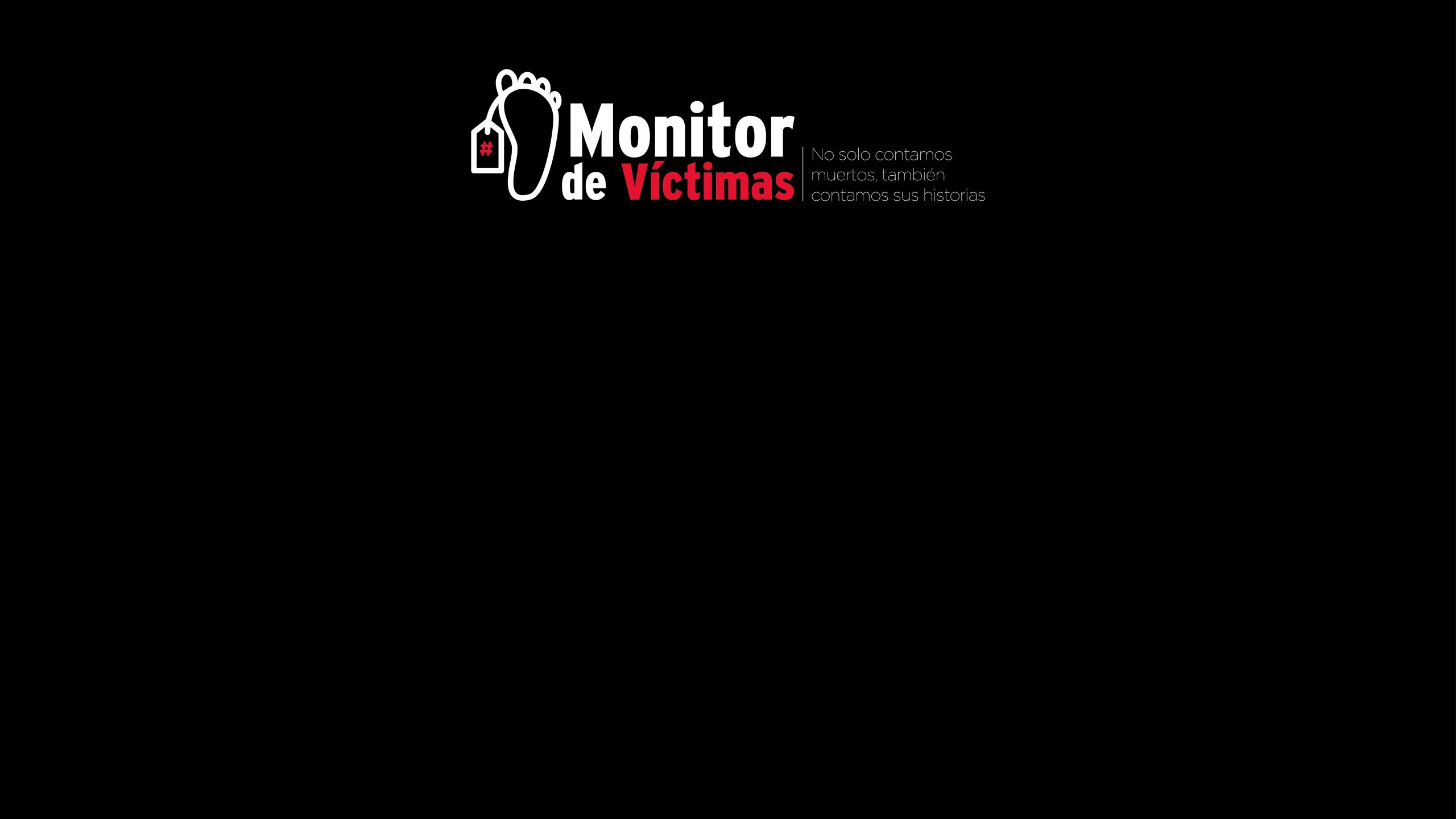
898 homicides occurred in Caracas in 2019. This report not only shows the data on violence in the Venezuelan capital but also draws the profiles of the most vulnerable, who were victims of police lethality, robbery, revenge, and violence against women.
Versión en español https://alianza.shorthandstories.com/informe-monitor-de-victimas-2019/index.html
Young men who were caught early in the morning and in their homes by masked police officers who ended their lives. Older women who were murdered in their homes to rob them. Adolescents who died in the middle of vengeance due to past conflicts. According to data collected by Monitor de Víctimas, in 2019, the violence left 898 homicide victims in Caracas.
38% of people died because of extrajudicial executions or in cases of alleged resistance to authority. 18% of homicides occurred in the context of robberies and 23% due to revenge, gender-based violence, quarrels, and others. In 21% of cases, the motive for the homicides that occurred in Caracas is unknown.
Runrun.es and Caracas Mi Convive drew the profiles of the typical victims of homicidal violence in Caracas. They were the most vulnerable to bullets, bladed weapons, and assaults that last year filled the Venezuelan capital with red figures, with an estimated rate of 30 homicides per 100,000 inhabitants.
Consult the total numbers registered in 2019 here: Monitor de Víctimas 2019
Dying in the hands of the police
The aftermath appeared from day one. The fear of going out alone does not leave her alone. "I am afraid... I live terrified. If I go out and see someone outside dressed in black, I start to tremble" says the mother of Luis Gerardo Cabello Bulén, a 20-year-old boy who, at around 4:30 pm on October 7, 2019, was kidnapped by the Fuerzas de Acciones Especiales (FAES) of the Bolivarian National Police (PNB). Luis Gerardo was abducted while returning to his home in Zone 9 of the "José Félix Ribas de Petare" neighborhood in the Sucre municipality located in the Miranda state. Hours after his arbitrary arrest, when it was already night time, his family found him dead in the Domingo Luciani Hospital located in a nearby neighborhood called "El Llanito". He was shot in the back.
Cabello Bulén was one of the 340 people who, according to data collected by Monitor de Víctimas, died at the hands of the State security forces in the Caracas Metropolitan Area during 2019. This 340 represents 38% of the total number of murders registered in the Venezuelan capital last year. The same day of his shooting, the young man's mother explained that the FAES killed three other men in the "José Félix Ribas" neighborhood: Jefferson Álvarez Jiménez, Gerald Torrealba and Keyber David Landaeta Villegas. None of them were over 30 years old.
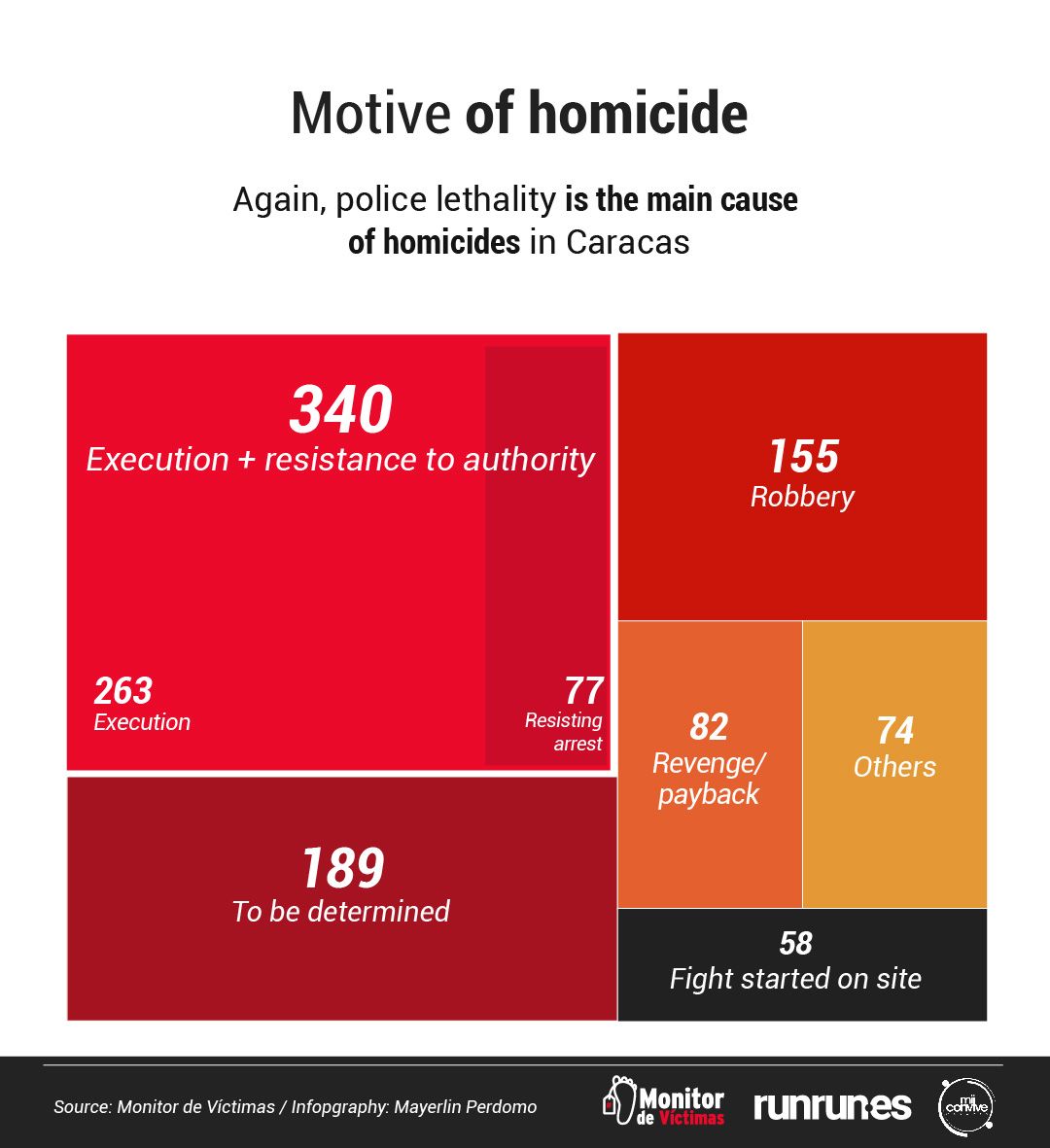
Several of these four boys' characteristics correspond to the general profile of the police's victims: they were young, dark-skinned men, ranging from the age of 20 to 29 years. In this age group, 50.8% of the registered victims by the police fit this profile. Only Landaeta Villegas differed from the statistics: he was 18 years old.


The police lethality victims also share other characteristics: they had a medium or primary educational level, and were unemployed or depended on unstable jobs. Álvarez Jiménez and Landaeta Villegas fulfilled those characteristics. While the first was an informal salesman, the second worked as a piece-rate blacksmith. Cabello Bulén did not have a permanent job either, since he only worked as a construction worker on weekends with one of his uncles, as he studied the fifth semester of Administration at the Palo Verde headquarters of the Simón Rodríguez National Experimental University. Torrealba, the oldest of the group (26 years old), had a more economically stable position, he was a computer technician.
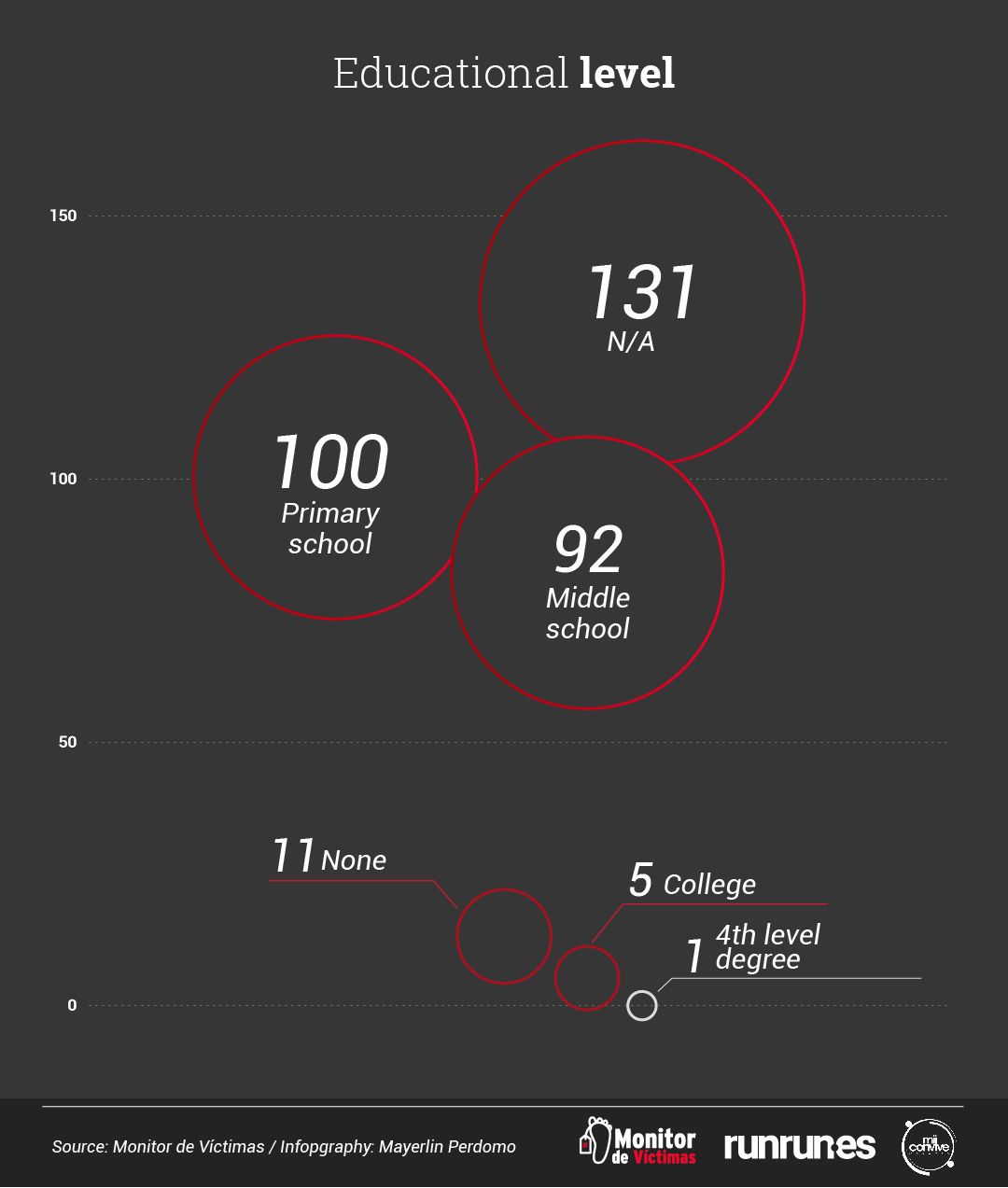

The vulnerability of these young people to die in the hands of the police in working-class neighborhoods has caused families to make drastic decisions to protect themselves. For example, Cabello Bulén's mother explained that after the murder of her eldest son, she preferred to send the youngest one out of Caracas so that what happened to his brother would not occur to him. She fears that, as happened to the young man, one day, he will run into a street in the neighborhood with a police officer willing to kill him without reason.
"We are all afraid here because the police have killed many children and shoot them even when they are wearing a high school uniform. Even my nephew, who is eight years old, pees himself when they tell him that the police are coming," says the woman.
The fear of the Cabello Bulén family has its basis in statistics. Most of the homicides by police lethality were carried out on a public road (50.8%), as happened with the four young men massacred. The second scenario where these deaths occurred was in homes, with 45% of cases. Police lethality is the one with the highest proportion of murders that occur inside the victims' homes.
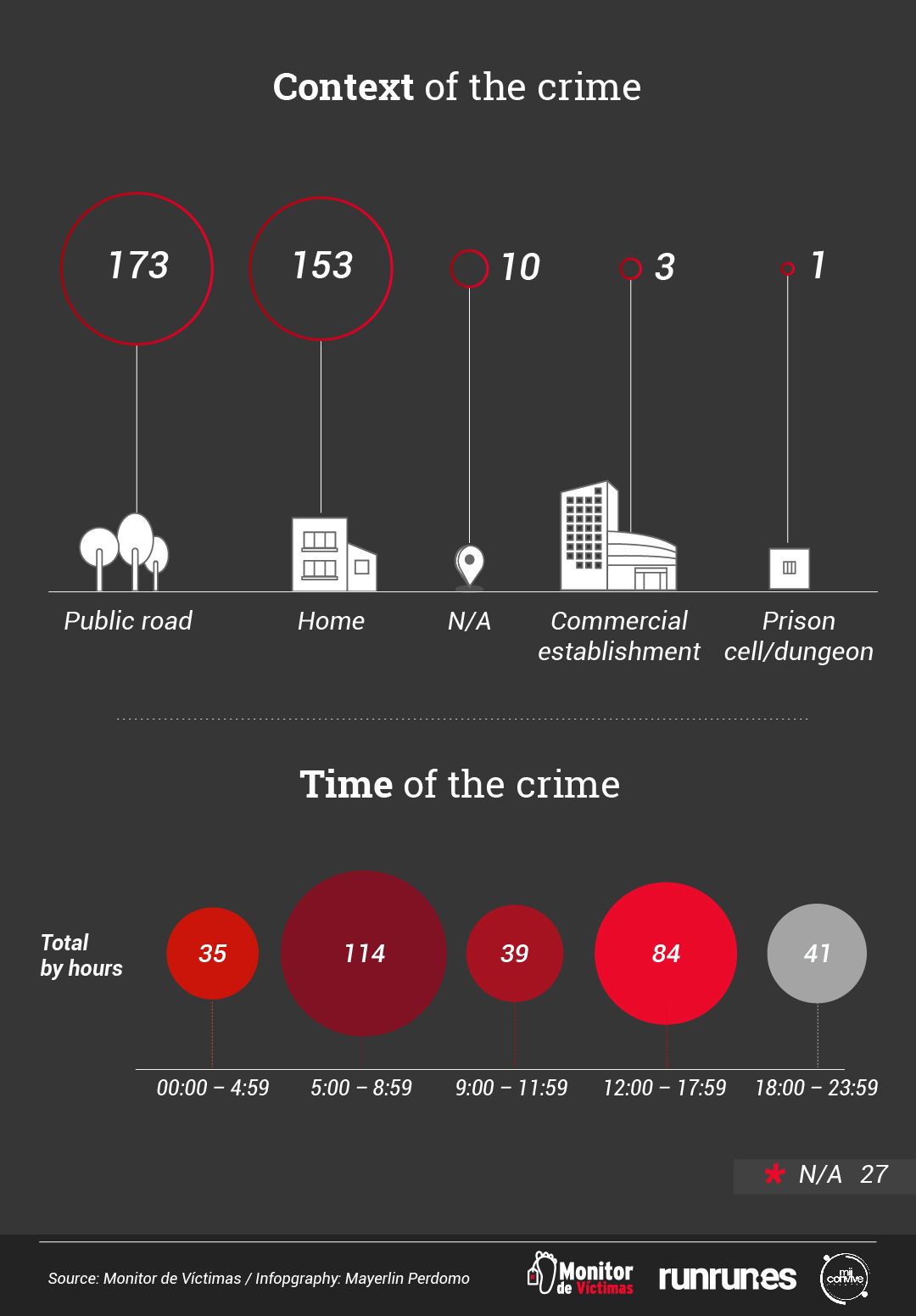
Petare, where the massacre took place, is precisely the parish of the Caracas Metropolitan Area with the highest incidence of police lethality. In 2019, 71 cases were reported there. Nonetheless, the Libertador municipality constitutes the borough with most deaths in police officers' hands, with 226 total. The Sucre and El Valle parishes located in Libertador registered 34 and 33 police lethality cases, respectively.
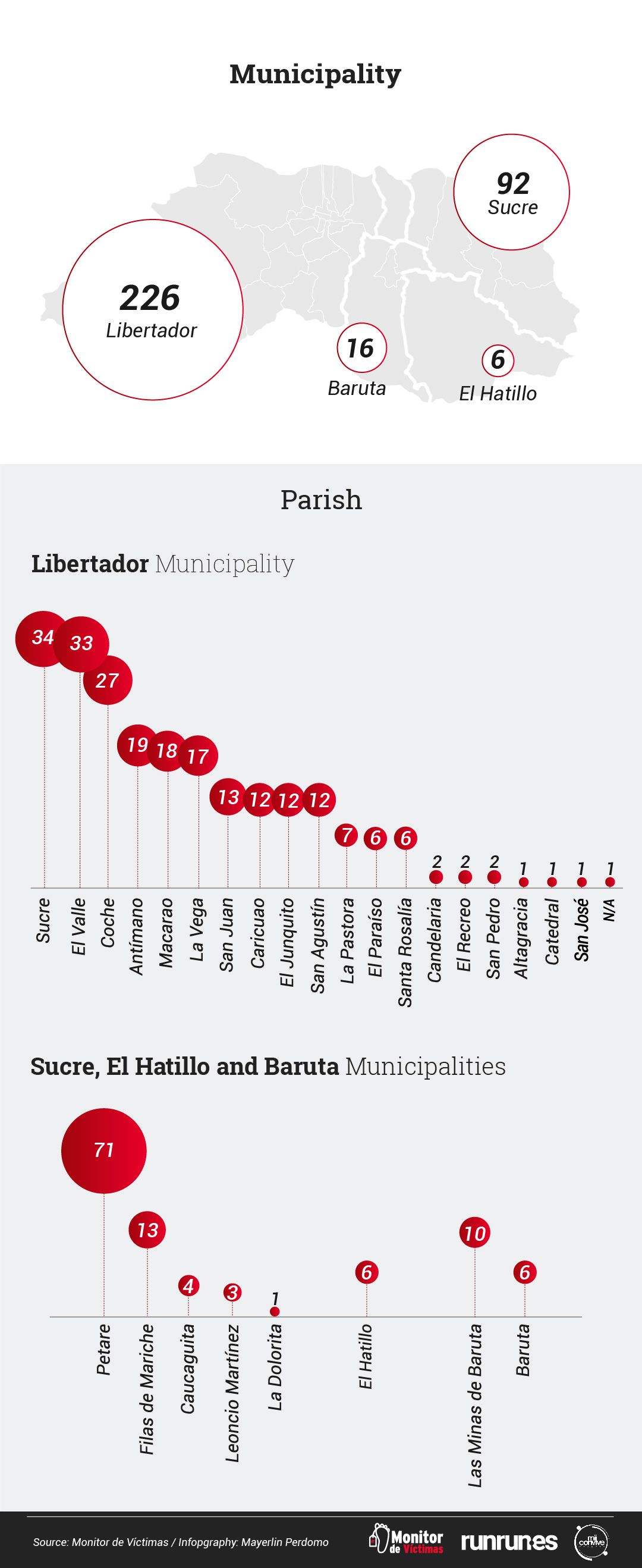
It should be noted that the number of deaths in the Libertador municipality is because it concentrates two-thirds of the Venezuelan capital population. However, the homicide rate for police fatality is higher in the Sucre municipality (where Petare is located), where 13 cases occurred per 100,000 inhabitants. In Libertador, the rate is 11 per 100,000 inhabitants.
The deaths caused by police forces happen in two different situations. One of them is the extrajudicial executions, which means a violation of the human rights of the victim by security officials, who attack them even though they did not represent any danger to the integrity of the police officer or their surroundings. 263 people died in Caracas because of this motive in 2019, which is equivalent to 29% of all homicides in the city.

The killings of the four young men in Petare were the result of this crime, because - among other things - it was not reported that the victims were armed, making a confrontation with the authorities virtually impossible. According to testimonies of their relatives, all were arrested without a warrant and without being caught in flagrante delicto. Both of these conditions are established by the Venezuelan Penal Code to justify an arrest.
However, the official police report justified the murders of the four boys claiming that they were criminals. "All of these individuals belonged to the dangerous criminal organization of "El Wilesis "(Wilexis Alexander Acevedo Monasterios). The gang of "El Wilesis" is accused of being involved in multiple homicides, road piracy, trafficking large amounts of narcotics and psychotropic substances, illicit behavior, and intimidation," said the report of the FAES (the special unit of the Bolivarian National Police). The report also detailed that they had seized two revolvers, a pistol, and a shotgun. The relatives of all of the victims denied to the press that the young men were involved in crimes.
The data collected by Monitor de Víctimas points to the FAES as the main victimizer among police corps, with 232 cases registered, constituting 68% of all police lethality cases. The number of deaths in the hands of this corps represented an increase compared to the data of 2018 when this security body was responsible only for 42% of the homicide cases committed by the security forces.
FAES is the same security body that the United Nations High Commissioner for Human Rights, Michelle Bachelet, has asked to dissolve due to a large number of complaints of police executions that it has accumulated since its creation in mid-2017 to mid-2019 (more than 7,000 throughout the country). In response, the government of Nicolás Maduro has praised the operations of this unit. Officials such as the Minister of the Interior, Justice, and Peace, Néstor Reverol, have denied that the uniformed officers have committed these crimes. The FAES, together with the Scientific, Criminal and Criminal Investigations Corps (CICPC), concentrate 89% of the police fatality deaths registered in Caracas in 2019.
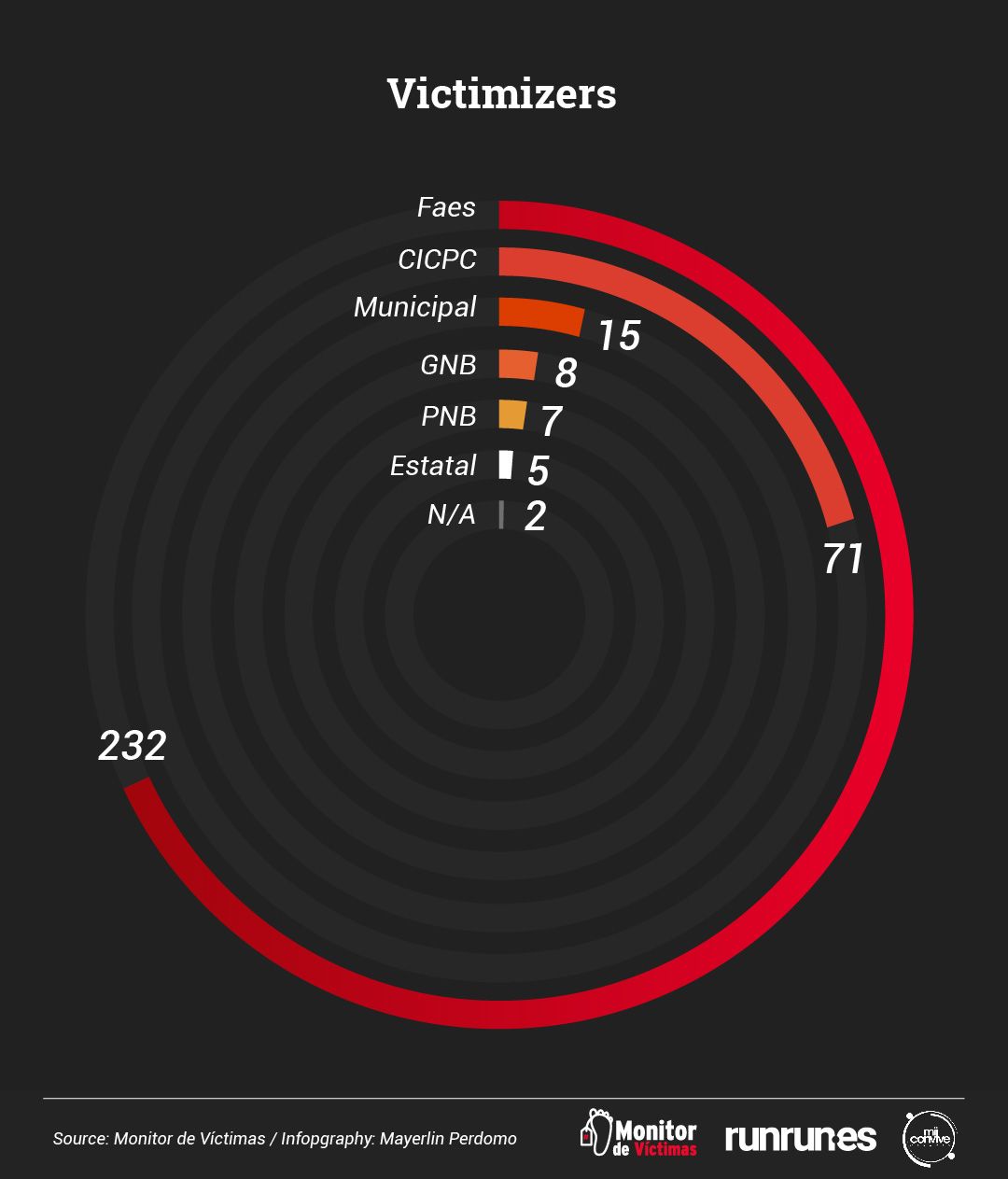
The nightmare of police abuse did not end with the assassination of the young men. After the massacre, the intimidation of the police against the relatives of the victims began. They remained inside the neighborhood in the following 24 hours after the event. Cabello Bulén's mother remembers that she had to close her son's Facebook account because from time to time, publications and montages were sent to her son's account that tried to accuse him of crimes. False photos of his corpse, in which his head was entirely shot, were also uploaded to the social network. He only received an impact in the back.
The other context in which deaths occur at the hands of the police is resistance to authority, which implies that the alleged criminals confront officials with weapons, forcing them to act proportionally to save their lives or those of other people. 77 people fell because of this reason in the Venezuelan capital last year. However, various irregularities in the reports suggest that these deaths were, in fact, executions.
According to Monitor de Víctimas database, there are 29 cases in which it was not certain that the victims confronted the police since it was not possible to know if they were carrying a gun when they were shot. According to the testimonies of their relatives, three of these people were not carrying any kind of weapon.
That is the case of Neomar Antonio Galindo Aponte, 29, who had escaped from the detention center of the CICPC Homicide Unit station in El Paraíso, western Caracas, on September 11, 2019. That same day he died in an alleged confrontation with the police of that same force. However, in the declarations that Douglas Rico, director of the institution, offered five days later on the facts, he only mentioned that 8 of the 29 inmates who had escaped had been recaptured. The victim's relatives learned of his death through the testimony of a former cellmate. "I have not been able to speak to the authorities, they did not inform me anything, we found out of his death from another prisoner," said a relative when approached by the media. The body was found in the morgue a week after it entered.
There is another inconsistency detected in cases of resistance to authority. The number of dead civilians significantly outnumbers the amount of injured or dead police officers in these clashes.
The "resistance of authority" cases has less support when they include massacres such as the one that occurred in Petare, where they were no fatalities among police officers. Or the one that happened in the El Estanque sector in the Barrio Bicentenario of Coche (Southwest of Caracas), on August 27, 2019, when the FAES killed seven alleged members of "El Peluca" gang and the policemen resulted unharmed.
The police report indicated that all the victims were in the same house when they were surprised by the officials. This characteristic is repeated in 45% of the homicides by police lethality, where the victims were inside houses when they were surprised by the public force. Also striking is the time at which they were killed: 6:00 am, just the time slot (between 5:00 am and 8:59 am) in which the majority of the cases because of this motive were presented: 114 of 340 homicides at the hands of the police, equivalent to 33.5% of the total.
In 2019, only four police officers died while on duty, while the security forces killed 340 civilians, which means that, for every officer killed on duty, security forces killed 85 people. The "expected" ratio, according to experts, is ten civilians for each police officer. This disproportion is an indicator of the excessive use of lethal force by the authorities.
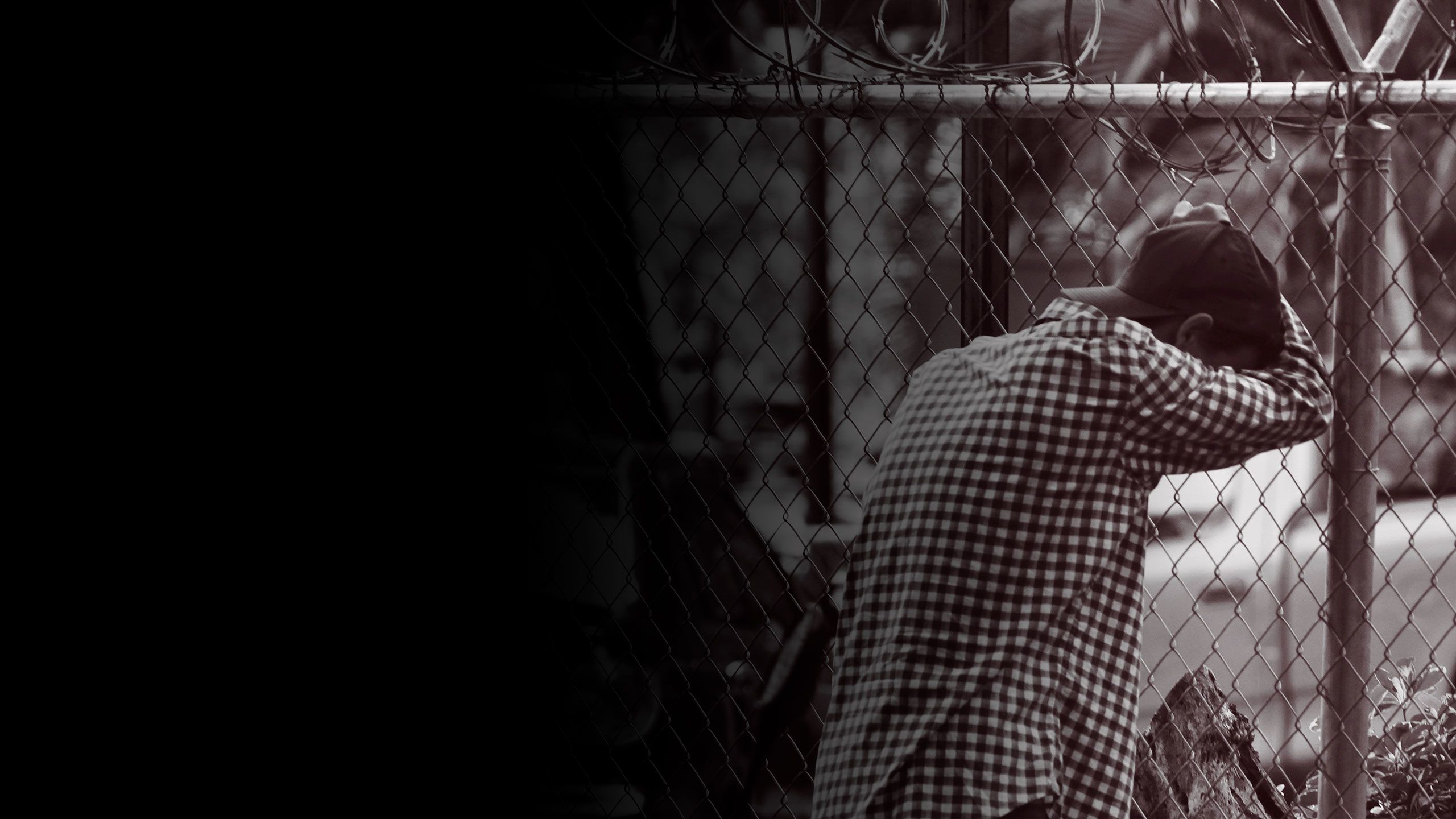

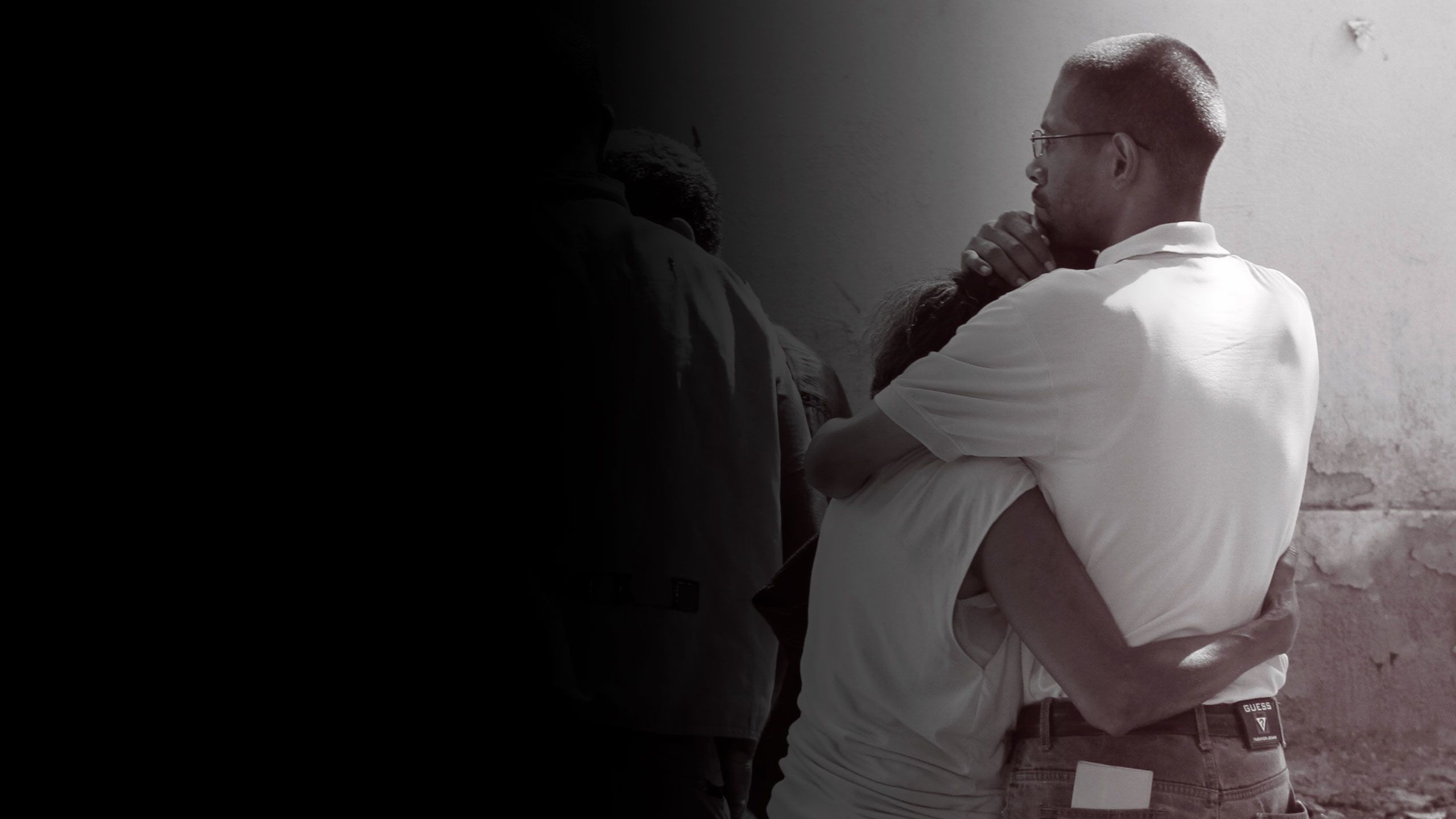
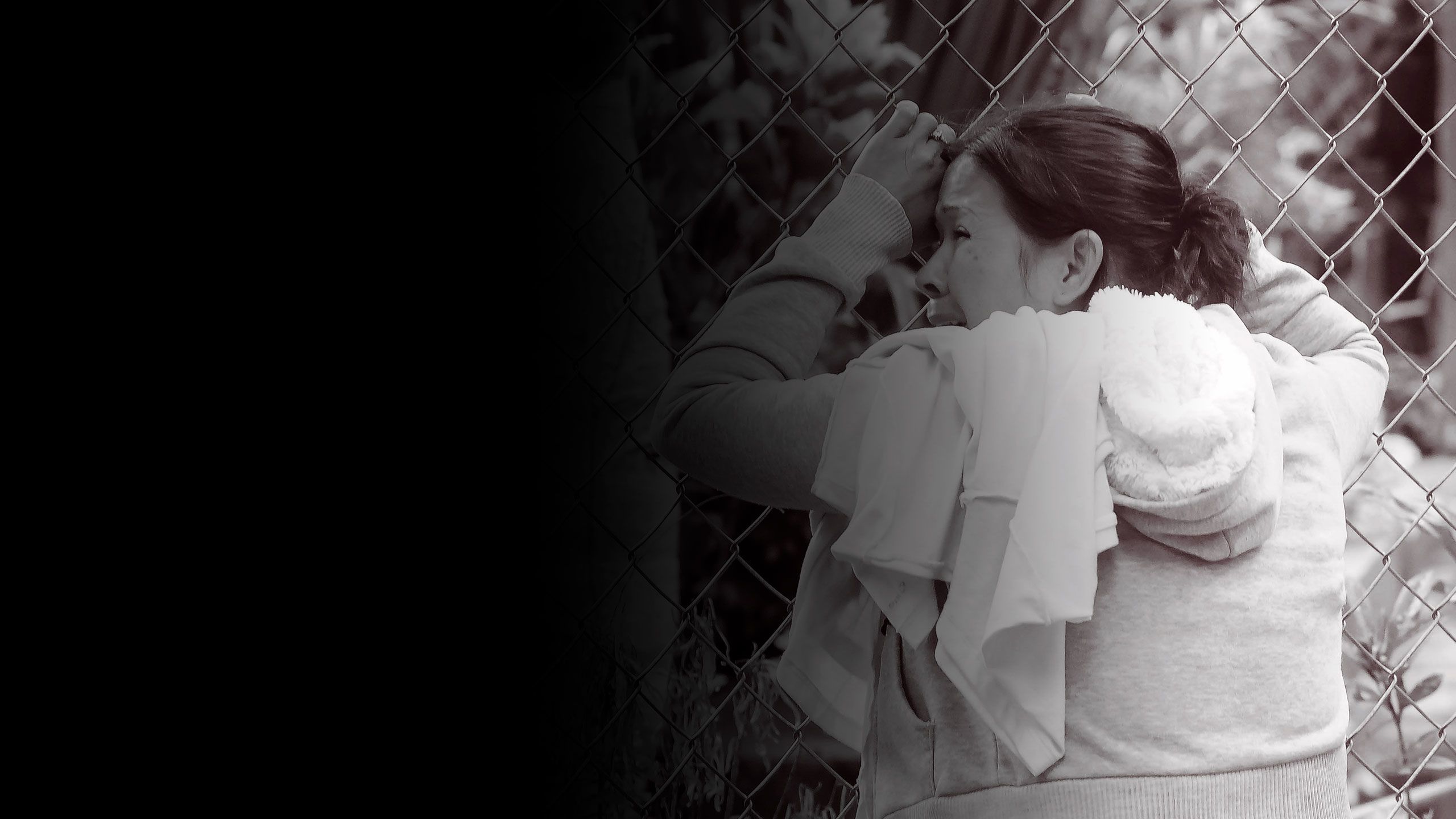
“We are all afraid here because the police have killed many children and shoot them even when they are wearing a high school uniform. Even my nephew, who is eight years old, pees himself when they tell him that the police are coming”, says Luis Gerardo Cabello's mother.
The deaths caused by police forces happen in two different contexts. One of these is extrajudicial execution, and the other is resistance to authority.
"I have not been able to speak to the authorities, they did not inform me anything, we found out of his death from another prisoner," said a relative of Neomar Galindo.
Being killed because of a motorcycle or mobile phone
Rony Daniel Freitez Aular, 28, was killed by thugs trying to steal his motorcycle. He had left his house in the Plan de Manzano sector, near the old Caracas-La Guaira highway, the night of April 19, 2019, to meet some friends in La Piedrera. However, during his journey on the Caracas-La Guaira highway, a group of criminals approached him to steal his vehicle. In the attack, he was shot twice, wounded with a machete, and set on fire. National Guard officers helped him but he died in a hospital the following morning. 90% of his body suffered burns.
The young man was one of the victims of robbery, the second most frequent motive of homicide in Caracas, comprising 17% of the total violent deaths. His murder occurred on a public road, just like 75% of cases, and happened in the Libertador Municipality, the place where most deaths by robberies occurred (94 deaths, 61%). The Libertador and Sucre Municipality were the scene of 91% of the homicides in the midst of robberies.
It was in Sucre where 21-years-old Yorbi Fajardo was killed, specifically in the El Tanque Sector of the Petare parish, the parish where more robbery related murders occurred (37 out of 155). On March 26, 2019, amid the blackouts that affected Venezuela, he was walking towards his home while lighting the way with his cell phone. It was precisely for this reason that he became the target of a group of men who surrounded him to steal his device. When he refused, he was shot several times. Although neighbors and family members left their homes upon hearing the gunshots, the boy died at the site.
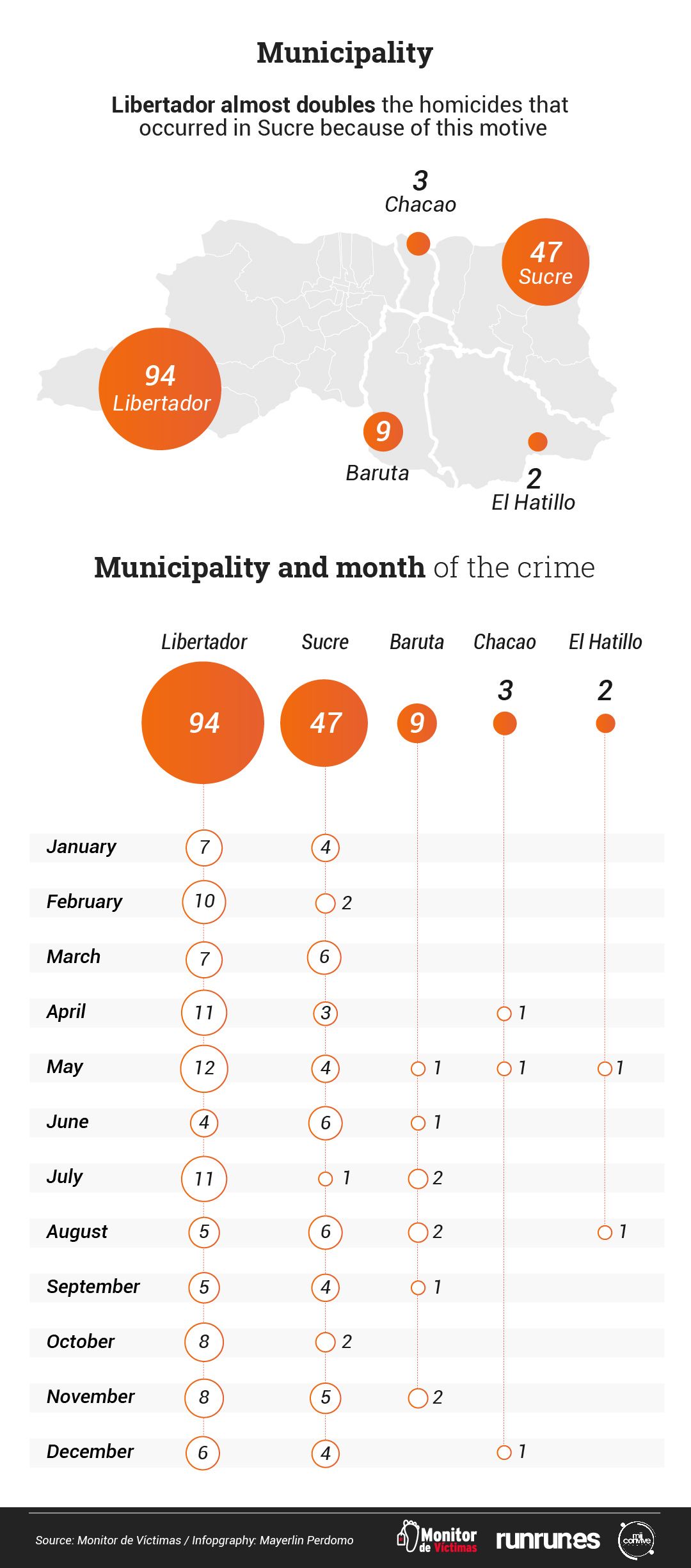
According to the data collected by Monitor de Víctimas, the fatal victims of robberies were young, dark-skinned men, whose ages ranged from 20 to 29 years, such as Freitez Aular and Fajardo. This was the most affected age group, concentrating 26% (41 cases) of those killed by this motive. Then, there were those over 50, who represented 23% (36 cases) of the total.
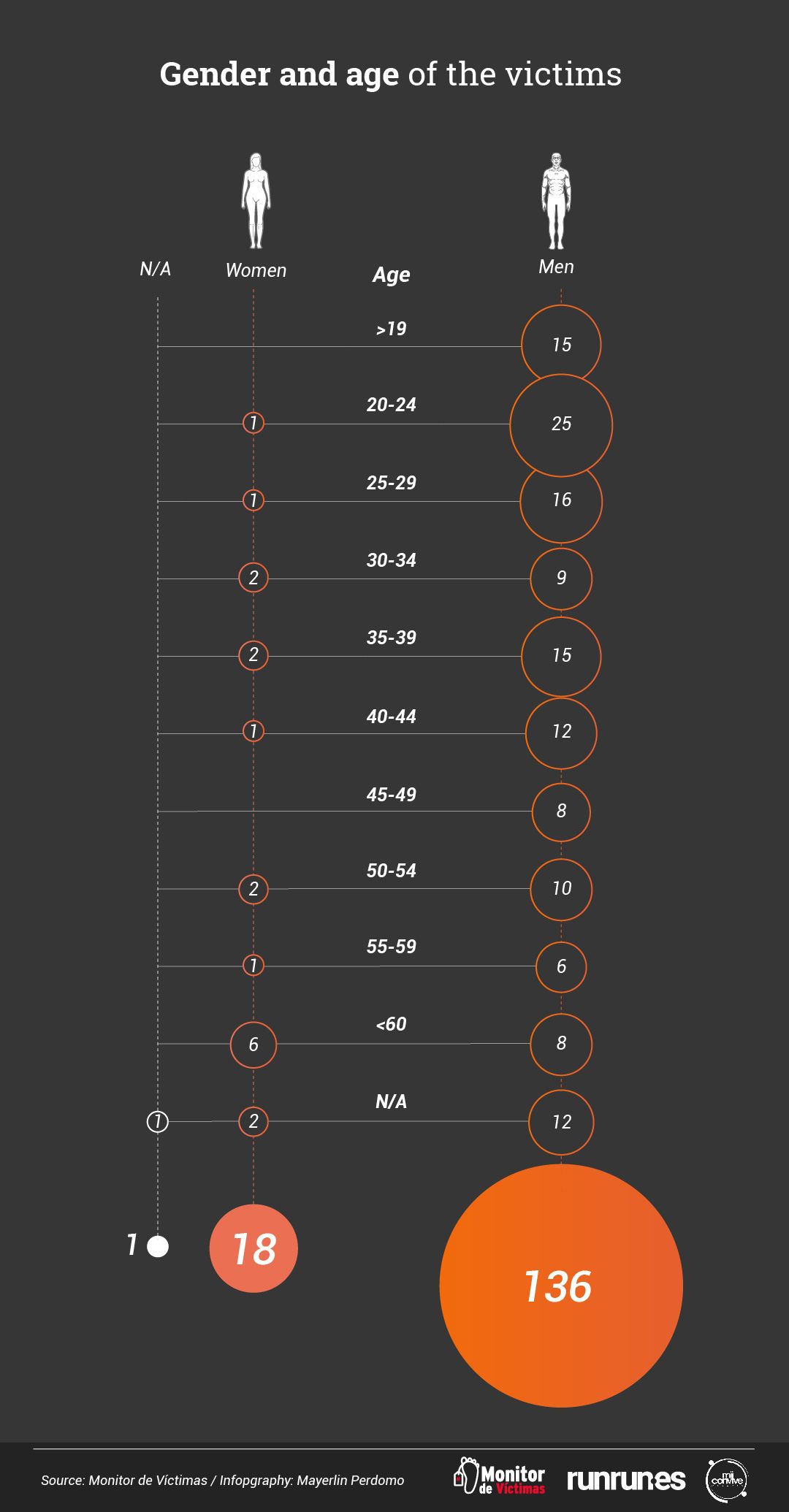
In 84% of registered homicides, the victim was an unarmed civilian, just like Freitez Aular and Fajardo. Both of them were shot with firearms, joining other 101 people (65%) who also were shot when they were being robbed.
Most of the homicides by this motive (54%) occurred in the night and early morning hours. Both victims were murdered around 10:00 pm.

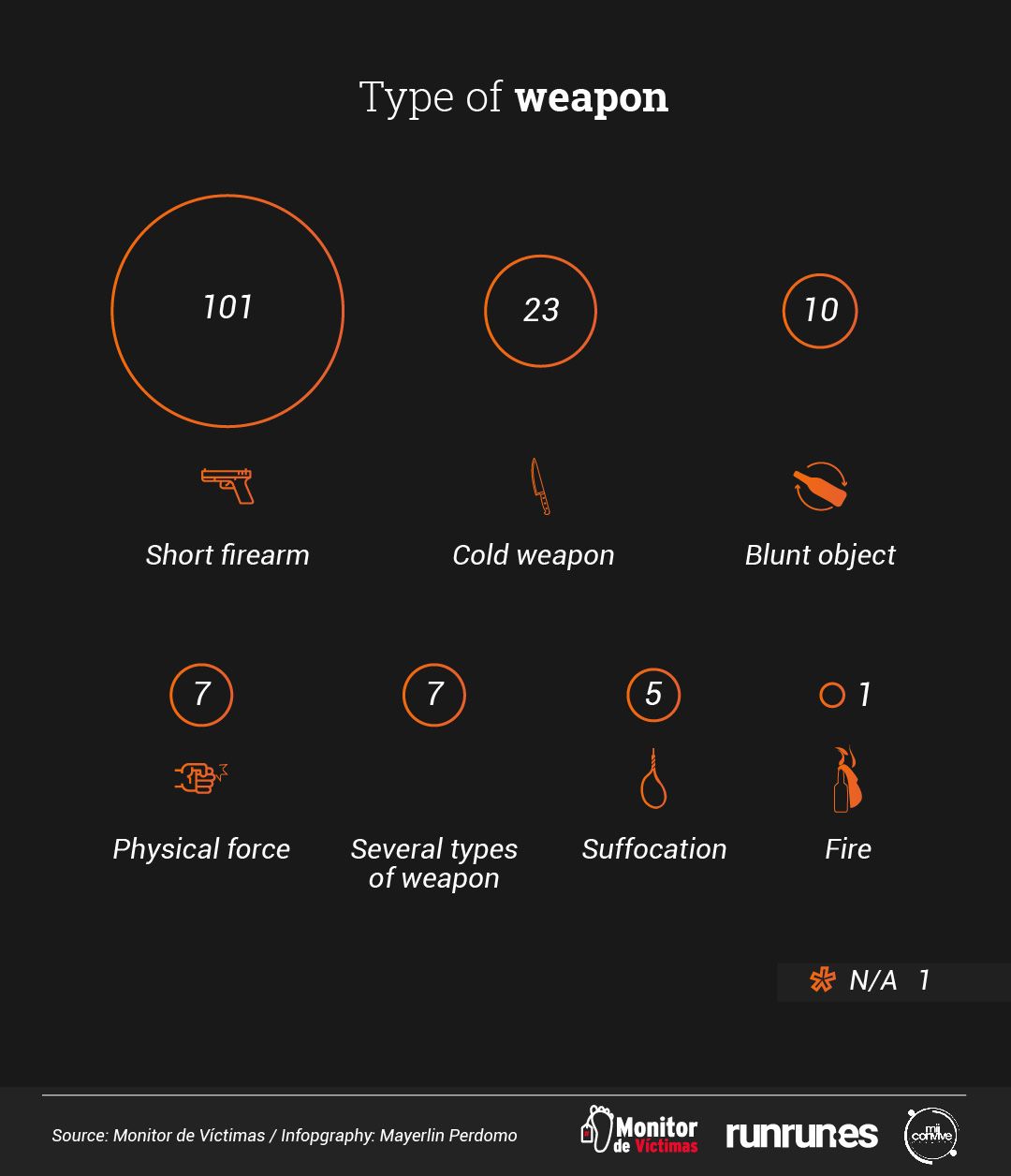
Revenges or "paybacks"
The bodies of Juan Carlos Parra Orozco, 22 years old; Dany José Barreto Bernal, 18; and a 17-year-old teenager appeared on the morning of Friday, December 2, 2019, on the banks of the Guaire River, at the height of the old highway that connects Macarao with Los Teques, in the Libertador municipality, southwest of Caracas. They had disappeared four days before when they left their homes to work in the neighborhood of Barrio Nuevo, where they were working clearing a terrain near a house. Allegedly, they were shot because of a previous conflict.
The payback or revenge murder, in which the victimizer kills as a result of a past or current conflict, was the fourth most frequent motive of the homicides registered in Caracas in 2019. Under these circumstances, 82 people died ( 9% of 898 cases), including the three young men from Macarao previously described. According to the data collected, 98.8% of the victims were civilians like them. While 57 people were not armed at the time of the attack, as happened with Barreto Bernal, Parra Orozco, and the teenager, there were only three of the total cases in which the victims did have a weapon.
The data also indicates that the majority of the victims were male (92.6% of the total). Only five women were killed under this modality and at least 1 transgender lost his life for this reason.
Most of the victims were men in their teens or early adulthood, as the young man from Macarao. They belong to the two age groups most affected by these homicides. The first group, between 20 and 24 years old, represents 20.7% of the victims, while 18.2% were between 15 and 19 years old, as Barreto Bernal and the adolescent. There were also 12 minors among those killed by payback or revenge, among which two children, aged 3 and 4, stand out, who lost their lives due to physical abuse at the hands of a family member after a couple's discussion in their homes.

The municipality most affected by this motive was Libertador, where 55 deaths were registered (67% of the total) because of revenge. Nonetheless, the parish with the highest number of homicides due to this motive was Petare, located in the Sucre municipality of Miranda state. There, 13 people died for this reason.

One of the victims from Petare was Jeison José Amundaray Valera, 25 years old, a worker who was killed with a machete at his home in the El Cañaote neighborhood while asleep. The event occurred around 4:00 am on October 19. His family presumes that the victimizer was an ex-boyfriend of his partner. She disappeared after the murder. The data indicates an average of 7 monthly deaths in the Caracas metropolitan area during 2019 due to payback or revenge.
After Petare, the parishes where there were more deaths because of this motive were Sucre, Coche, Antímano, La Vega, 23 de Enero, and Santa Rosalía. There, 36 victims were registered (65% of those occurred in the Libertador municipality). These seven parishes accumulate 60% of the total cases of payback or revenge.

More victims because they were women
Deylimar del Carmen Velásquez and Johana Alexandra Mejia Solis were 23 years old when they were killed last year in Caracas. In addition to the fact that they were 23-year-old women, in both cases, their offenders were their partners. They were both policemen.
According to the data collected by Monitor de Víctimas, 66 women lost their lives in a homicide in the Caracas Metropolitan Area. Of these 66, 19 died from gender-based violence, such as Velásquez and Mejía Solís. The figure represents 29% of the total registered cases where the victims were female.
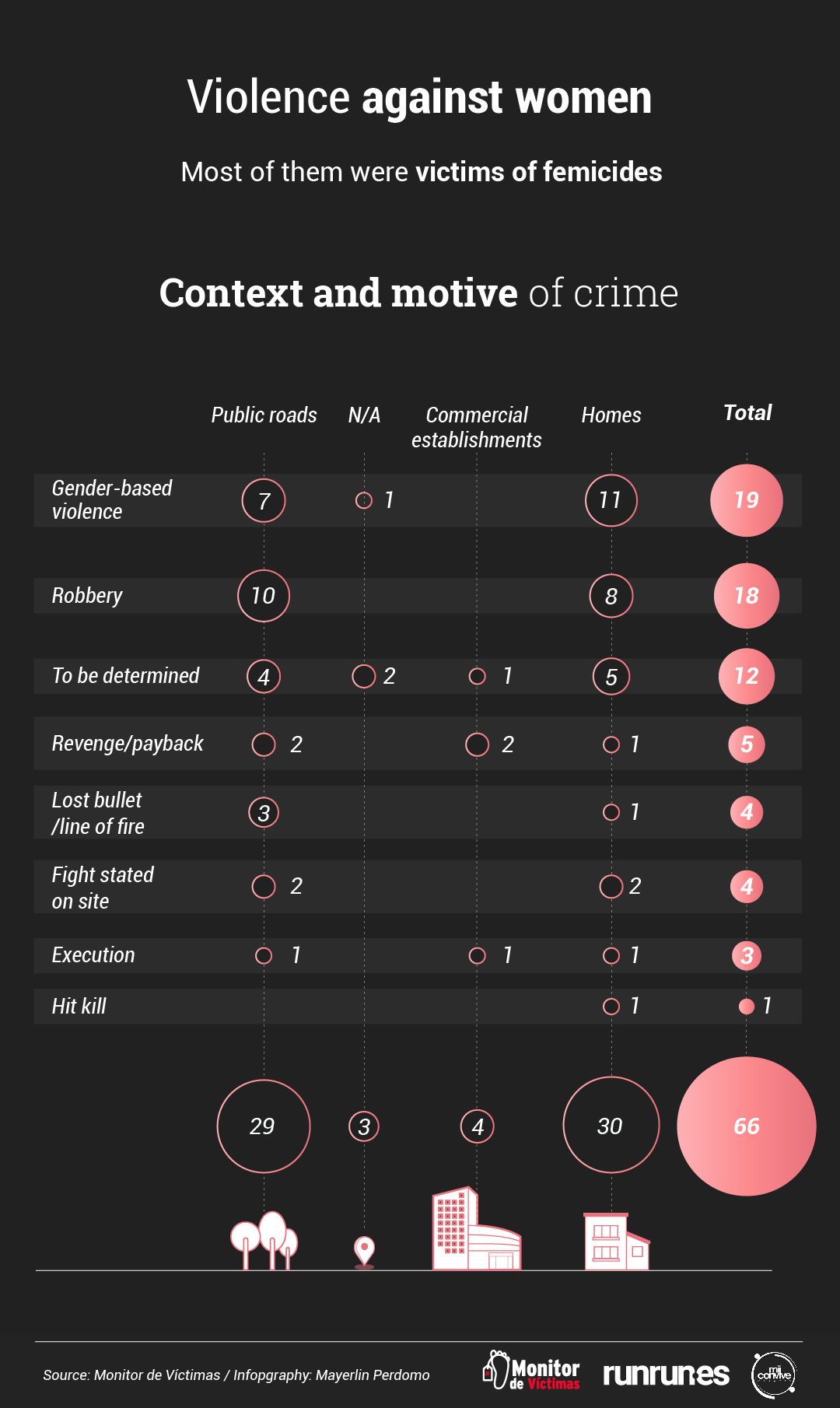
Velásquez was killed for making a complaint to his partner. On the night of May 25, 2019, at approximately 11:00 pm, she was at his home in La Dolorita, Sucre de Miranda municipality, along with his sister, two friends, and his partner, a FAES official named Yondri Zambrano.
In the middle of the evening, she saw a conversation that her boyfriend had on the phone and argued with him about the content. The man's response was to take out his gun, shoot him in the head, and flee the crime scene with the two friends. Although Velásquez's sister asked the neighbors for help, the young woman died inside her home.
Three months earlier, on the night of February 18, 2019, the murder of Mejía Solis occurred also in La Dolorita at the hands of her boyfriend, the Polisucre officer Liunder Martínez. The official's statement indicates that his work's pistol slipped while they were at home and the shot hit the young woman. But a second version indicates that he pointed his gun at the girl while they were arguing. She took his hand away and at that moment the pistol fell and the shot went to his body.
The two women murdered by their partners were young females between the ages of 18 and 30, as well as 32% of the women who were victims of homicide last year. That was the age group most affected by violence against women during 2019.
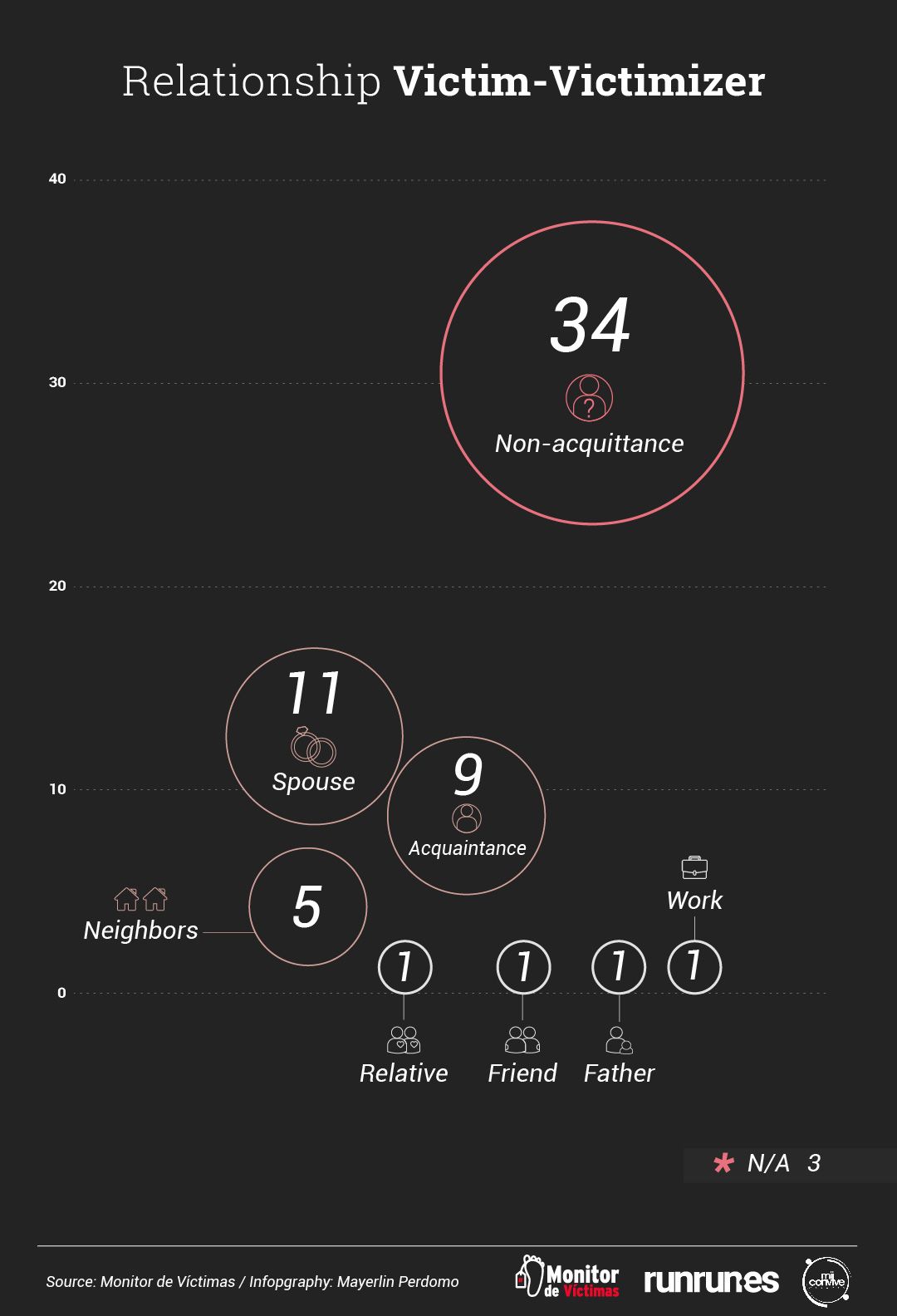
Velásquez and Mejía Solís were housewives, as were 41% of the victims. None had finished high school, as 37% of the women killed in Caracas in 2019. Only Velásquez was the mother of a child. All the women murdered in 2019 left 64 minors orphaned.
Both young women had other things in common. Both were killed inside their homes, like 45% of the women who died violently in Caracas. This characteristic is even more significant in gender-based violence cases, whereby 58 % of these deaths occurred inside the homes of the victims. In 47% of the murders, the victimizer was the husband, as happened with Velásquez and Mejía Solís.
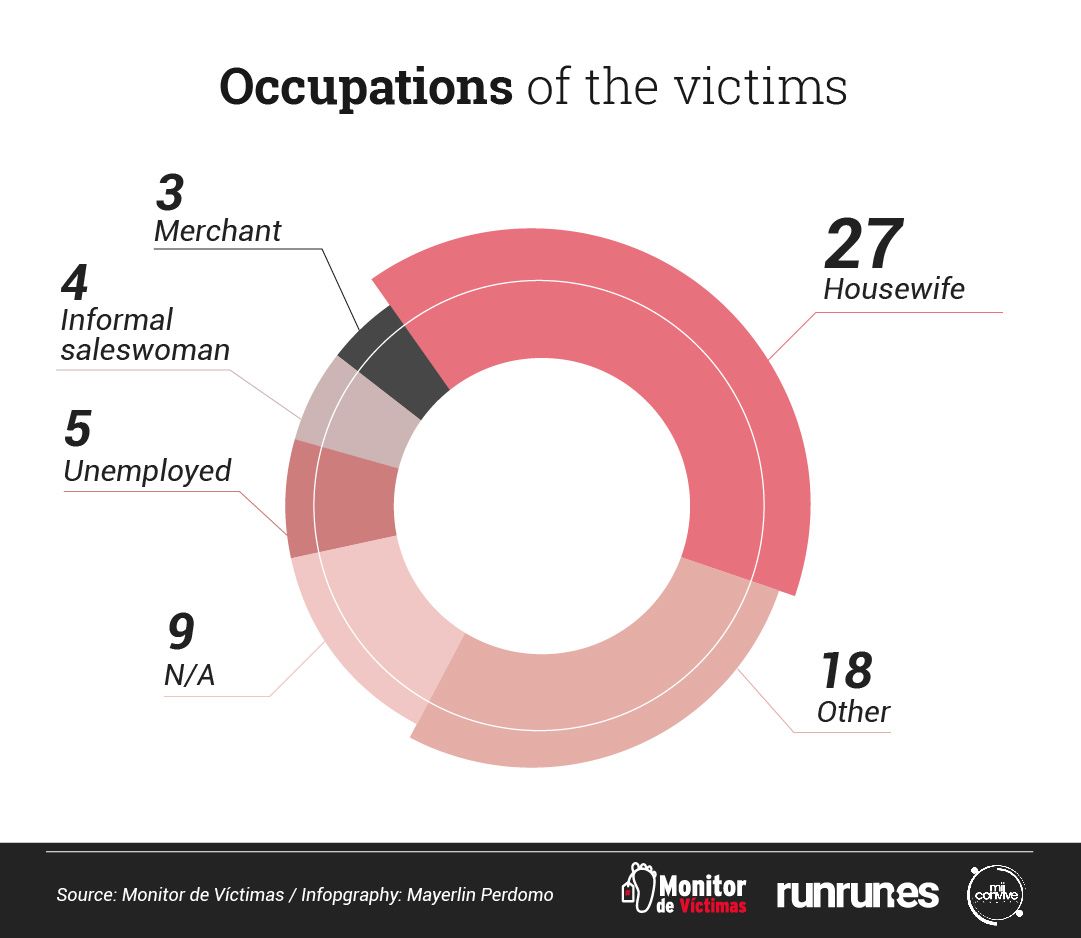
The second motive for which more women were killed in Caracas was "robbery". 27% of the total female victims registered by Monitor de Víctimas in 2019 died from this cause. In these cases, the age group most affected changes. The most vulnerable were women over 50 years of age (50% of the total victims). Also, 67% of those over 50 were killed inside their homes.
This profile includes the murder of Ana Mireya Amore Reyes, a 76-year-old woman who was murdered by an employee of the condominium where she lived alone in her apartment, the Parque Santa Fe Residences, in the Baruta municipality of Miranda state. On September 17, 2019, she left around 5:00 pm to escort the lady that cleans her apartment to the nearest bus stop. Upon returning to her car, the security guard who had been working for a couple of weeks at the scene, Juan Carlos Serrano, 24, subdued her to steal her vehicle.
The discovery of the crime occurred days later when several belongings of Amore Reyes were found in the condominium water tanks' room. Bloodstains also appeared on site. The following day, Civil Protection officials from the municipality dived into the tank and found her body. Her victimizer had beaten her to death and plunged her body into the water. The security cameras recorded the moment when the security guard left the crime scene with the car of the septuagenarian.
.
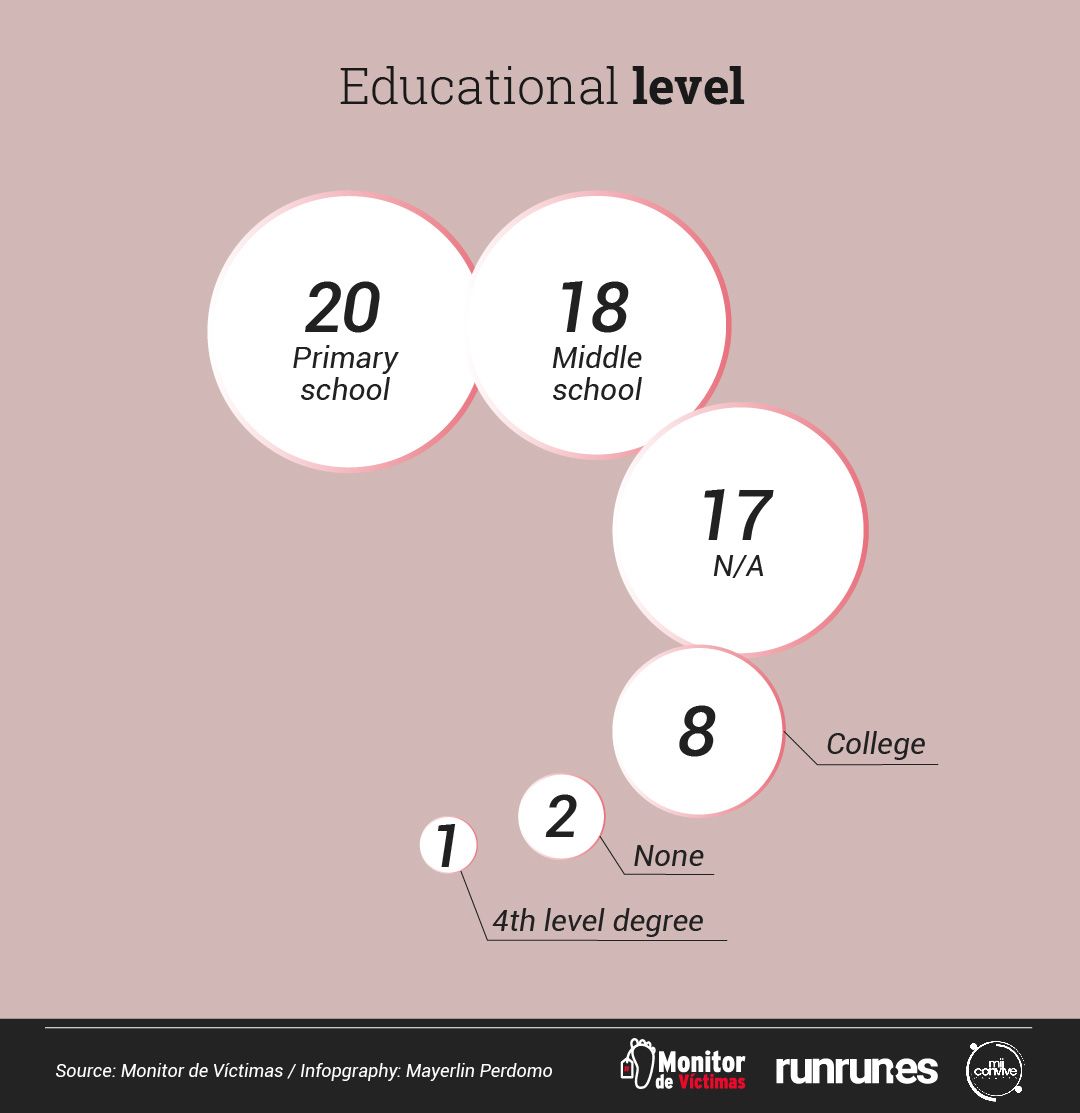
Although in 2019, the number of homicides that occurred in Caracas decreased, some variables changed compared to 2018. These modifications show the lack of protection and vulnerability of some of the inhabitants of the five municipalities of the Caracas Metropolitan Area.
Homes have become crime scenes increasingly frequent. 30% of the homicides occurred when the victims were in their homes or of family or friends. The number of murders that occurred inside people's homes represents an increase of 6% compared to 2018 and shows that insecurity could be spreading to households.
On the other hand, the security forces remain the main victimizers of homicides in people's homes. Additionally, 45% of the cases of extrajudicial executions and resistance to authority occurred in homes. The public force not only does not protect the lives of citizens but also violates the privacy of their homes with violence.
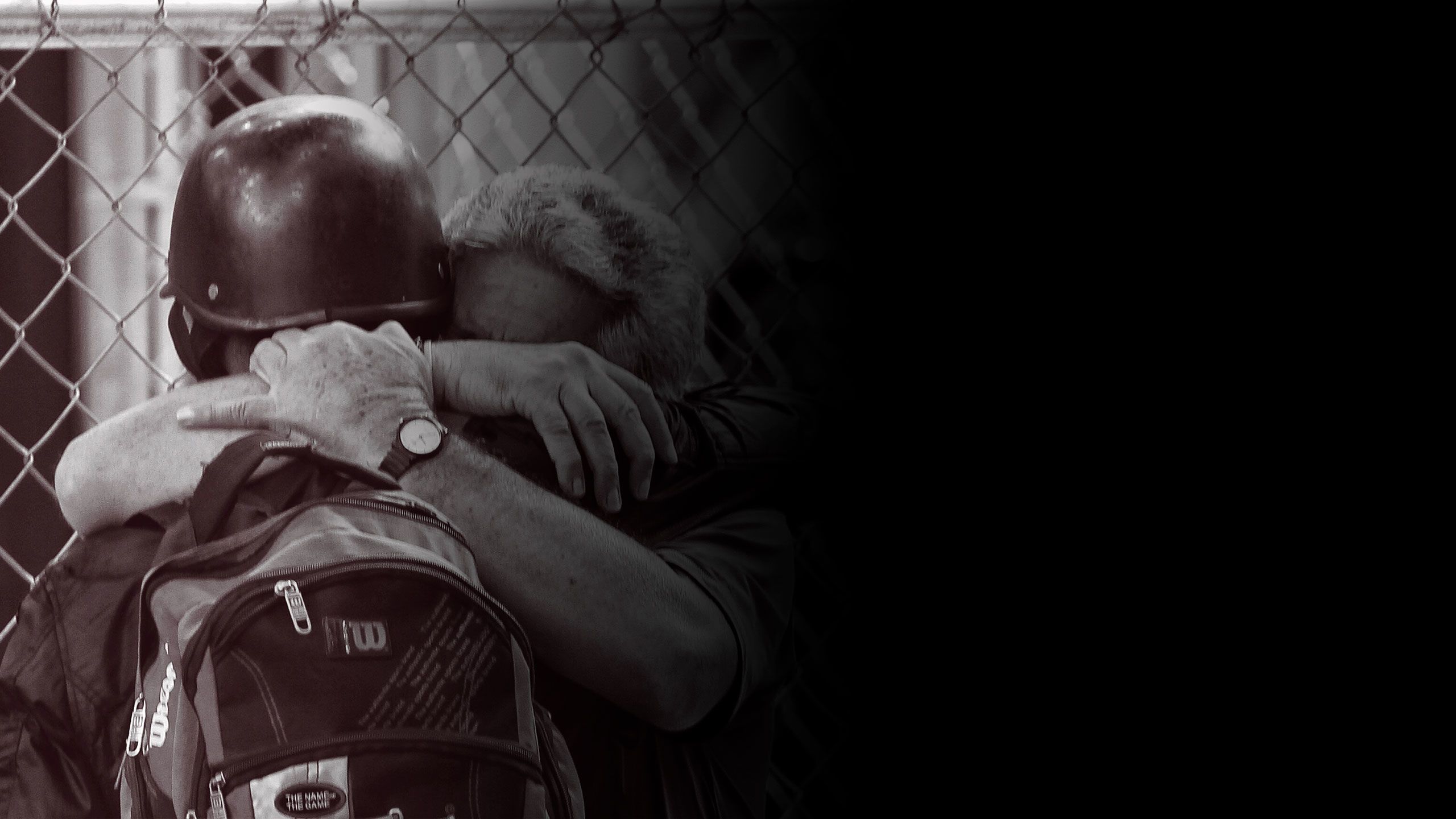
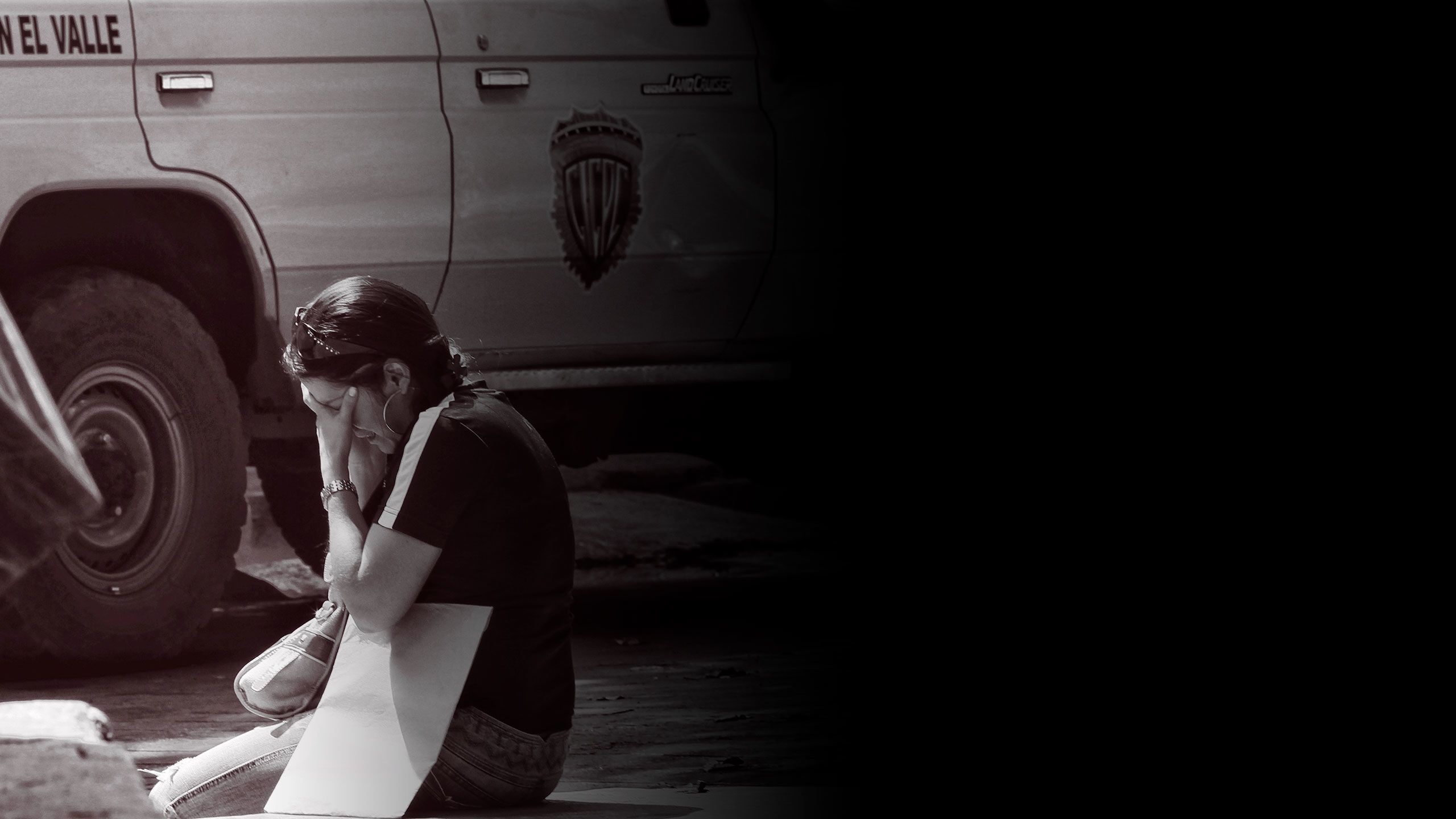
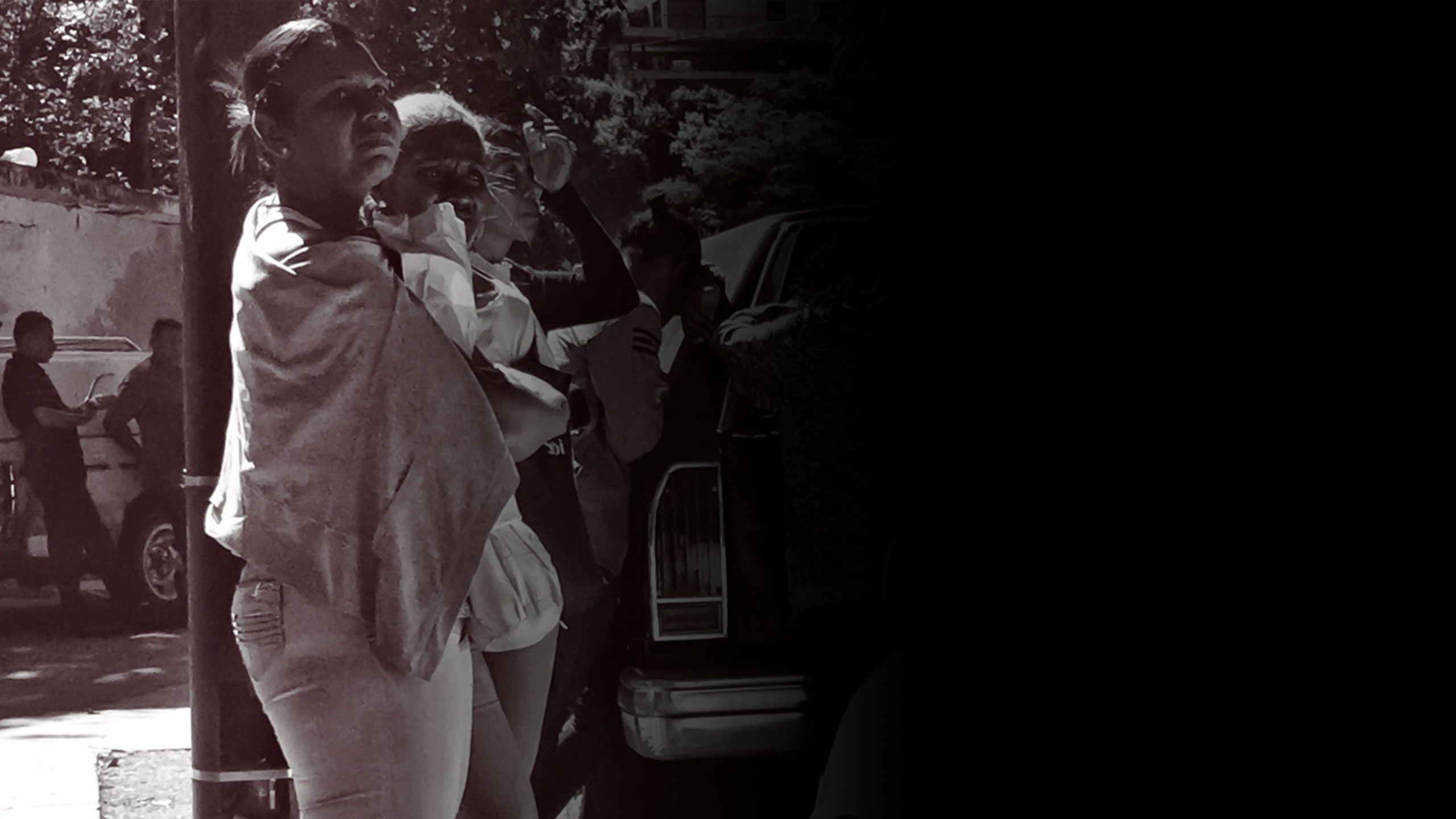
"A statistical analysis of the patterns of police lethality”
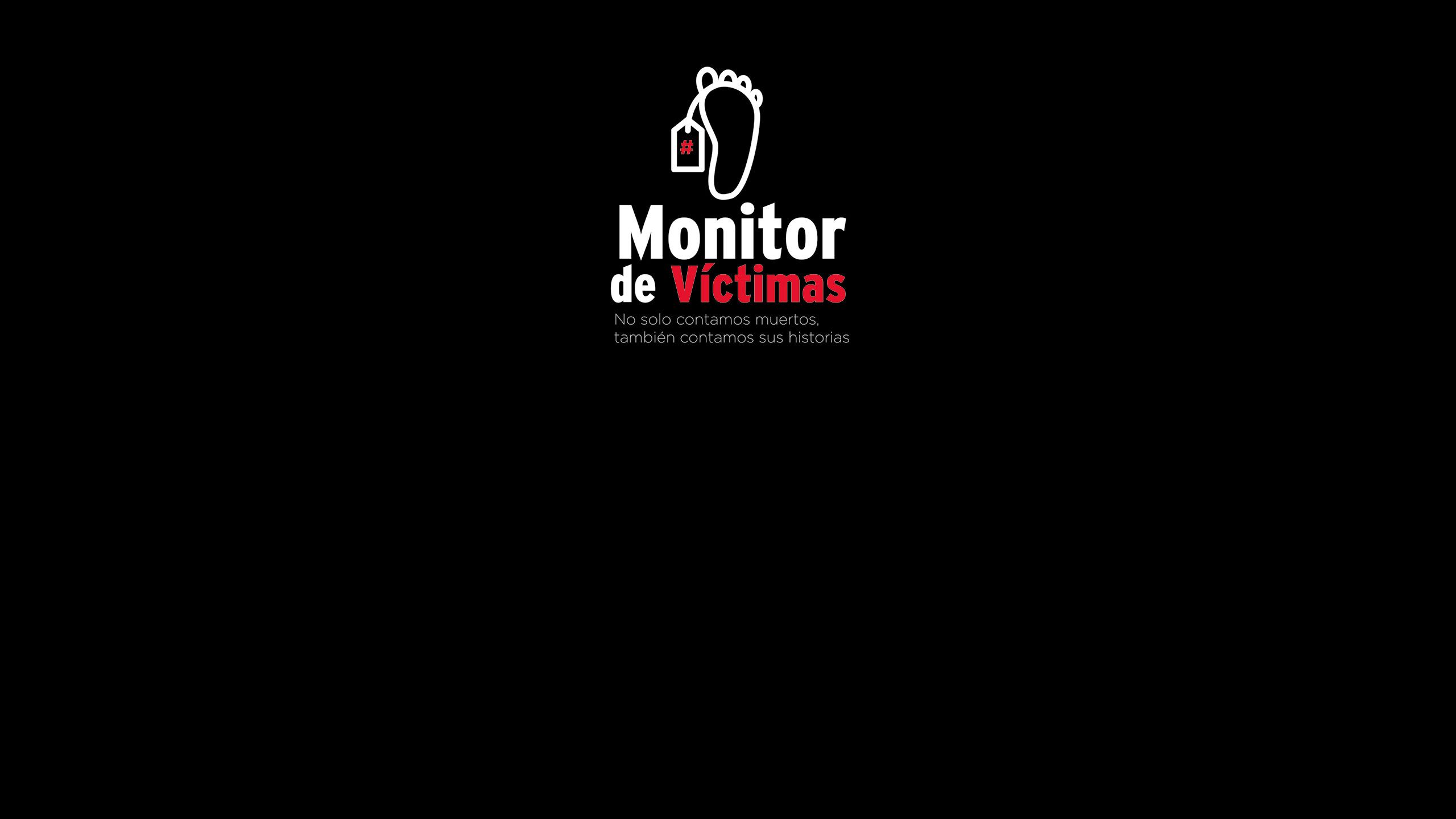
Inferential analysis of the data
Police must follow multiple protocols that ensure respect for human rights. In this sense, when the police act in a lethal manner, there should be no cases in which the victim was unarmed and died inside his home. Mainly because under these conditions, the victim is at its most vulnerable situation, and the use of deadly force is disproportionate and unnecessary. Understanding this, we asked ourselves the following questions: In cases of police lethality, is there an association between the victim being unarmed and dying inside his house? In turn, does this association occur in cases where the police are not involved?
If both variables are associated in cases where the police are responsible, it implies that the security forces are more prone to be accountable for deaths where it seems that the victim could not have resisted. If this association does not appear in the rest of the homicide's motives, we are talking about the fact that murders committed by the police have a different pattern from the other homicide perpetrators in Caracas.
Data analysis may point us to a systematic pattern of abuse by law enforcement agencies. 677 cases with known motive were considered, and they were classified into two groups: those involving police lethality -composed by the sum of the cases of resistance to authority and extrajudicial executions- and those where the police were not involved - made up of the sum of the rest of the motives, where the civilians were the perpetrators-. (Look at Annex 1)
Afterward, each group's Chi-Square test results are shown to analyze if there was an association between the victim being unarmed and dying in his home. This analysis compares the observed cases with the expected distribution of the data when there is no association. If the police procedures had not followed a systematic pattern against victims who are vulnerable (in their homes and unarmed), the results of this analysis should not be significant.
The existence of a statistically significant Chi-Square (X2 = 15.6) (p <0.01) in cases of police lethality, implies that the frequency of deaths of unarmed victims in their homes by the police does not seem to be attributed to a random pattern. In contrast, in the cases where the police were not responsible, this association is not found (X2 = 4.8; p> 0.01), so the frequency of people who die unarmed and in their homes seems to be due to chance. There appears to be an association between victims of police lethality dying in their houses and being unarmed. The magnitude of this association is low (contingency coefficient = 0.21), but this does not mean that it is non-significant.
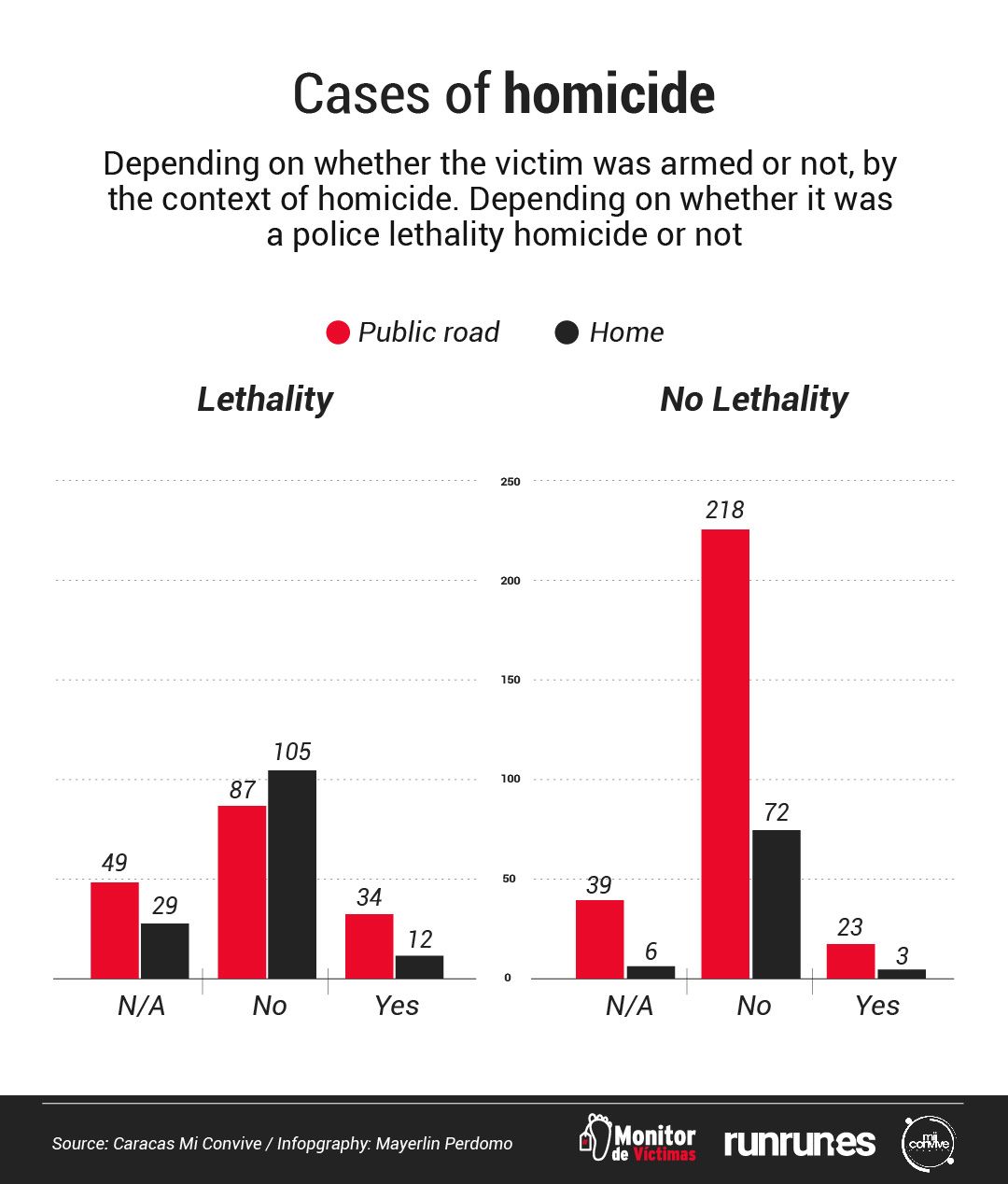
These results indicate that in cases of deaths where the police are not involved, the victims mostly die on public roads, regardless of whether they are armed or not. However, when the police act, that trend changes, and unarmed victims are more likely to die when they are in their homes. So, it seems that there is a pattern of behavior attributable to police forces that differs from the rest of the patterns of urban violence in Caracas.
However, the contingency coefficient of this association is low (contingency coefficient = 0.21). Therefore no conclusive statements can be drawn from this analysis. Low contingency could be explained in multiple ways. First, the lack of transparency regarding city homicide data by public institutions makes obtaining large-scale data difficult. Also, the methodology used by Monitor de Víctimas implies that there are multiple variables when collecting the testimonies that could be affecting the results. Finally, the police forces in Caracas are diverse and follow different acting ways, so defining unique patterns within these institutions is complicated. Despite this, the fact that a pattern such as the one mentioned is visible and statistically significant raises serious questions about the respect for Human Rights in Caracas.

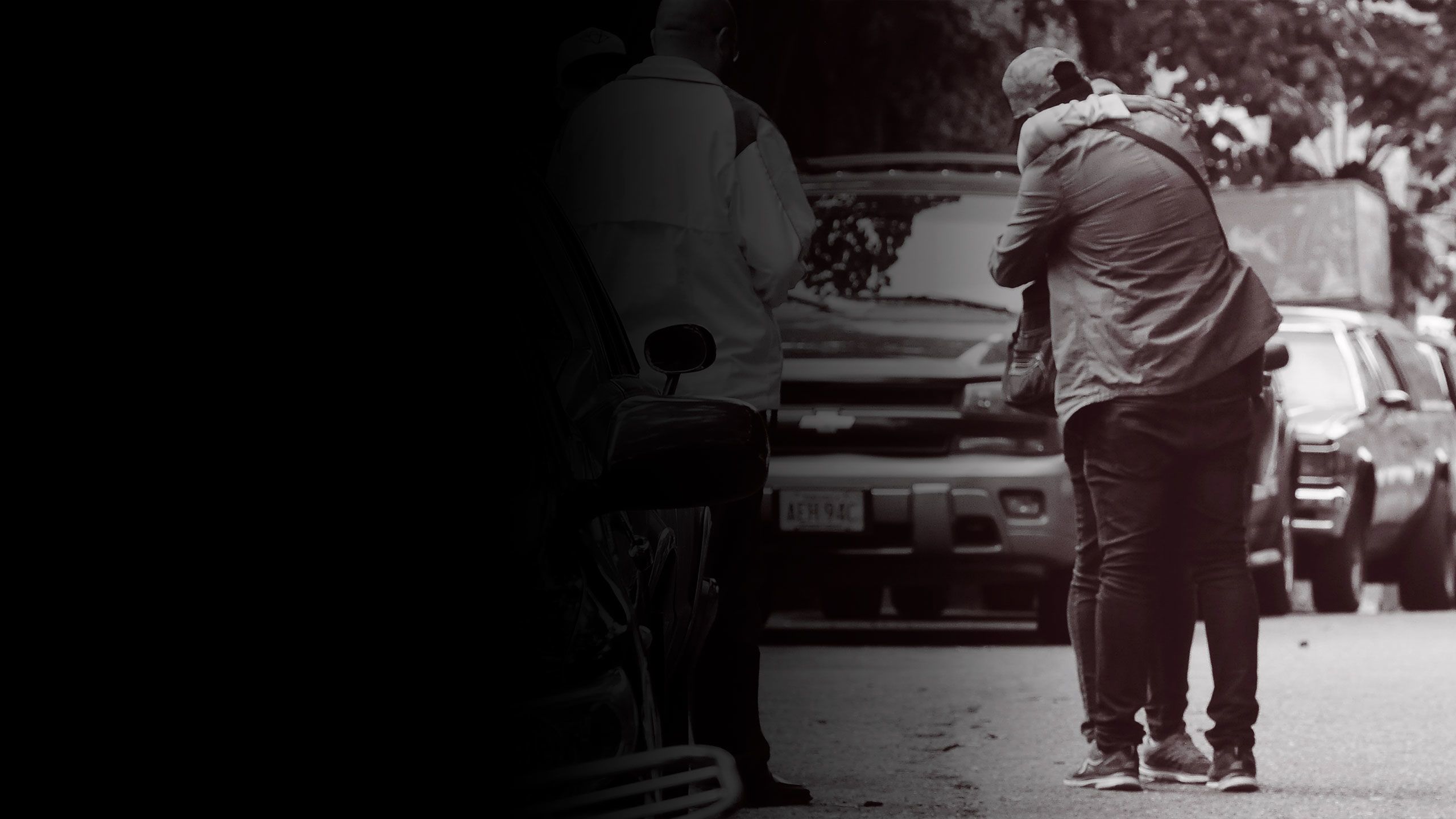
In the report, we observe that the security forces were responsible for 340 cases, 38% of the total deaths recorded by the Victim Monitor in 2019.
This section's objective is to take a glimpse at the patterns followed by the police before causing death and determine if there is a systematic pattern of violation of human rights.
Democracy, justice, and due process remain under doubt in the current context. When analyzing the Venezuelan panorama, we observe that the same conclusions repeat themselves, both when making statistical analyzes and when collecting testimonies.
These are the names of the 898 victims of homicide in Caracas.

These are the names, registered by Monitor de Víctimas in 2019, of those who died because of homicide in Caracas last year.
If any of your family's member's name is missing, please let us know at: monitordevictimas@gmail.com
JANUARY
Ricardo González Amundaray, Carlos Eduardo Ramírez, Brando Rafael Sanoja Batista, Maikel Cumare Avila, José Rafael Arévalo Pérez, Carlos Eduardo Pérez Sánchez, John, José Herrera Venera, Josues Antonio Rivera Ramírez, Yefferson Flores Trujillo, Ángel David Campos Álvarez, Karina Carolina García Hernández, Chirly Angely Colina Betancourt, Andris Jesús Gámez De Lahoz, Yender Alejandro Omaya, Noel Rogelio Rojas Blanco, Andreina Paola Ortega Arévalo, Yoel Oropeza, Yoswel Oropeza, Beiker José Viera Figueredo, Juan Castillo Alzuru, César Yonaiker Rodríguez Galindo, Miladys María Castillo Pérez, Jairo Alberto Seija Conde, Alixon dos Santos Pizani, Franki Alexander Figuera, Stefany Jajoy Natera, Kevin Antonio Cárdenas Blaquez, Luis Alberto Martínez, Adrián Aponte Odilio, Nicar Bermúdez Muñoz, Mercedes López, Davismar del Carmen Rodríguez Iglesias, Jonathan José Cásares Ramos, Oswaldo Antonio Cisneros Barrientos, Jesús Miguel Sanabria Rudas, Elizabeth Ramírez Durán, Geralbert José Jiménez, Jhonny Marcano, Yorman Yondeiker Vivas, Yoendry Enrique Fernández Pino, Jarrinson José Delgado Martínez, Gabriel Vicente Sojo Rodríguez, Fabio Acevedo Luna, Elio Jesús Romero, Anthony Daniel Meneses, Reison Lozano, Geralver Urbina, Enyerson José Machado Rodríguez, Jonathan Eduardo Maza, Yohni José Godoy Buitrago, Richard Montaña, Emilke Villanueva, José Luis Lorvez Cova, Jesús Ramón Roca Guarapare, José Antonio Jaime Morán, Alberto Carlos González Magallanes, Jhon José Herrera Venera, Yeferson Salas Díaz, José Alberto González, Jonathan Villegas Villegas, Hiter Alexander Flores, Asdrúbal Ramón Flores, Alexander Mantilla, Édgar Alberto Tagliaferro López, Ismael José Barrios Chirinos, Juan Carlos Yánez, Yonaiker Briceño, Zulay, Victor Medina, Danluis Cohen, Rainer Alejandro Berroteran Cordero, Víctor Manuel Arcia León, Geison Eduardo González Rosas, Sandro José Figueroa Rangel, Keimy Manuel Vargas Figueroa, Devin Luna Tovar, Juan José Castillo Alzuru, José Del Carmen Uzcátegui Gil, Rogelio Antonio Villanueva, Maicor De Jesús Hernández, Johan Arcángel Mora Urbina, Graciela Buenaventura Martínez Rodríguez, Frank David Correa Gutiérrez, Enyer Enrique Vaamonde Ovalle, Ismael Gabriel Rauseo Camacho, Mariano Barrios Galindo, Nick Samuel Oropeza López, Kelvi Jospe Jaspe Medina, Ana Lourdes Barreto Hernández, Ángelo Guanile Rondón, Asdrúbal Jonathan Suárez Bustamante, José Manuel Pacheco, Sandro José Figueroa Rengel, Arturo Alejandro Martínez Morales, Nenter Alfonso, Raúl de Jesús Figuera.
FEBRUARY
Luis Alberto Rodríguez Justiniano, Freider Toro, Yosmar Gacía, Vicente Cacique, Rainiel Romero Negrín, Jefferson Flores Trujillo, Luis Acosta Cabello, José Manuel Bertel Moguea, Josué Anthony Castillo Uzcátegui, Jorge José Guerrero, Ricardo Cacique, Richard Cleiderman Pérez Figueroa, Harry Josué Palma Marquina, Pablo Francisco Gómez Moreno, Juan José Rodríguez, Rainiel Romero Negrin, Noelkis Carolina Rámirez Blanco, Yafer Pineda, Jesús Elias Ávila Arcia, Yeiberson Fabier Molina Castro, Michael José Atencio López, Yorman Allende Figueroa, Anyer Simón Suárez Mercié, Alexander José Gutierrez Figeroa, Samuel Velázco, José Arteaga, David Arteaga, José Moisés flores Espinoza, Vicente Ramírez, Carlos Fernando Alonso Delgado, Wilkis Alberto Sevilla Miller, Deivis Ramces Brito, Yosmar Alberto García González, Gustavo Francisco Barroeta Hernández, Guillermo Antonio Rivas Apíscope, Alejandro José Márquez Quintero, Jofer Díaz, Ángel Raúl Nieves Amundaray, Kevin José Martín Rodríguez, Anderson José Estaba, Yoander Coronel, Gleybert Bolívar, Carlos Javier González Moya, Luis Jesús Bravo Reyes, Efrén Rafael Salazar, Jecksander Jambreiner Linares, Johana Alexandra Mejia Soli, Giovanny Alberto Rodriguez Suárez, Edgar Alberto Dávila Araujo, Richard Gerardo Avilan Castro, Alí Antonio Carrilo Linares, Stewart Jeremi Sosa Lobo, Carlos Eduardo Díaz Cuva, Cristian Eduardo Contreras Zerpa, William José Palao Domínguez.
MARCH
José Antonio Montilla Gutiérrez; Jhonny Ezequiel Rendón; Juan Carlos Retersillo; Tomás Sandero; Miguel Ángel Grilman; Rennys Rafael Fernández García; Luis Miguel Hurtado; Atilio José Martínez; Alí Ramón Domínguez; Flor Gutiérrez; Gabriel Arturo Calzado Franco; José Luis Franco; Yoandri Daniel Moreno; Carlos Augusto Erazo; Carlos Antonio González Ramos; Jesús Enrique Maza Riva; Chamberline Anyanwu; Marta Gutiérrez Tavarez; Gabriel David Godoy Robles; Duber Colmenares; Zamir Torres Brandino; Héctor Sánchez González; Omar José Hermoso Méndez; Yosef Daniel Virvod Rodríguez; Yumaiker Acosta; Maikel Alexander Berroterá Escalante; Omar Alarcón; Luis Alberto Mujica; Jesús Alberto Pérez; Simona Vaamonde; Roney Daniel Muñóz Garrido; Willian Francisco Alvarado; Franklin Antonio Barrido; Fabio Garrido; Alex Mota; Vlainer Andrés Mayora León; Alberto Nicolás Solano; Romer Jesús Gutiérrez Martínez; Jefferson Márquez; Daniel Alejandro Pérez; Carlos Javier Delve Domínguez; Ronald Jesús Barajas Trejo; Yorbi Fajardo; Joan Miguel Guerra López; Jean Carlos Ramírez Cadena; Robert Enrique Campbell; Ángel Javier Pereida Hernàndez; Jhonatan Eduardo Gil Parra; Manuel José Martínez; Manuel Hernández Blanco; Yonelbis José Arredondo; Juan Carlos Aguilera Barrios; Samir Antonio Torres Bracho; José Ángel Cabello Mindiola; Yordi Jesús Mendoza Rodríguez; Stefi Nicolás de La Hoz Fontalbo; Luis Alberto Pérez de La Hoz; Ángel Gregorio Durán Mercado; Eduard Alexander Pérez Salas; Freddy Sánchez Pérez; Laizner José Santana Jaimes; Omar Antonio Mijares Rojas; José Luis Cisneros Monasterios; Erick Jesús Acosta; Wilmer Ramón Bolaños; Johan Jesús Garrido Mangarré; Andry José Ferrer Gómez; José Gabriel Pérez Pérez; Edwin; Danielito; Henry; Miguelito; José Gregorio Hernández Marrero; Yorbin Adrián García Chacón; Bárbara Mayerling Rodríguez; Luis Alberto Henríquez Barrios.
APRIL
Jeferson Jesús Serrano Espinoza; Maike Pérez Torres; Brenderson Laya; Rutser Jesús Machado; William David Lara Ruíz; Luis Argenis Guzmán Cabrera; José Gabriel Castillo; Alfredo Gómez Rojas; Yoneker José Mora Martínez; Domingo Alfonso Calderón; Mark Luzón; Mario Mora Ramírez; Juan Carvajal; Luis Reyes Rengifo; Marvin José Martínez Calderón; Héctor del Carmen Rondón Lara; Agustín Vargas. Martín; Ramón Celestino Hernández Figueroa; Jesús Ilario Amarista Córdoba; Harrinson Chacón Rivas; Carlos Rafael Vidal; Alberto Alejandro Mujica Guevara; Pablo Ramón Rodríguez; Freddy Rafael Aguirre Medina; Ángel David Duarte Valera; Vicente Rafael Olivo Valencia; Juan Ramón Chirino; Norbeta Díaz Liendo de Ibáñez; Ángel Gabriel Camero Martínez; Kéymer David Mago; Antony Rafael Mago; Orlando José Monasterio Salas; Ronny Daniel Freites Aular; Marc Nioeh Luzón Abreu; Oscar Alejandro Melo Vargas; Juan Gabriel Goitía ; Luis Maldonado; Leonardo David Yajure Araujo; David José Caraballo; Salomon Barrios Manjarrés; Yuni José Méndez Reitter; Oriana Orlaneth Pérez; Jesús mora Ramírez ; Carlos Eduardo Soto Castillo; Jackson Dario Domínguez Frontado; Alfredo Rojas Garcia; Jouberth Norwing Vargas Zorrilla; Rutxel Palma; Gabriel Esteban Vitar González; Miriam del Carmen Hernández Medina; Javier Alberto Morón Guaiquirima; Yajuare; Pablo Ramón Rodríguez; Ailin Oriana Silva Solórzano; John Paúl Rodríguez Álvarez; Zoraida Felicia Varela; Luis Alfredo Rojas García; José Gabriel Castro de los Reyes; Luis Manuel Acosta; Charlie Manuel Acosta; Johander Josué Sánchez Hernández; Erick Alfredo Bello; Régulo Andrés Figueredo Silva; Jesús Manuel Adalfio Ottamendi; Yobrán Leonardo Colmenares Hernández; Jean Carlos Montaño Pérez; Pedro Luis Alvarado Romero; Vladimir Enrique Cáceres; Marlon Jesús Mayz; David Sanz; Juan De La Cruz González; Andrés Guzmán Angulo; Lexer Román Delgado; Antoni Alfredo Patete, Inés María Rivero; Argenis Junior León Hernández; Alberto José López; Luis Eduardo Cordero Zambrano; Luis Daniel Hurtado; Edgar Castro.
MAY
Luis Alberto Rojas; Edward José Dávila Quintero; Enio Martín Heredia; Santana Rondón; José Ramón Sifontes; Luisa Oleta Martínez; Lizkeila Molina; Yorman Borges; Elic Infante; Dargenis Joneis Marcano; Angelo Moisés Osorio; Fernando Delgado; Wilder Calderón; Mauricio Maylander Vargas Melo; Elmison Motta; Darwin David Guevara Telly; Adrián Eduardo Mujica Ravelo; Gregory Arévalo Rodríguez; Yamil Castillo Carabalí; Adrián Alberto Aguiar; Freddy Junior Méndez Romero; Ruhf Jeinis Hernández Brazón; Víctor José Gregorio Romero; Pedro José Jaimes Chacón; Eli Rafael Infante Malavé; Keivi Alejandro Castellano Barboza; Keiver Alfonso Flores Cabrera; Joan Carlos Aponte Rua; Yehanike Mabel Rangel; Yerbintos Rosales; David Añes; Wolfgang Alexander Mariño; Richard Alexis Rojas; Nelson Rafael Hernández Machado; Yeiker José Florez Isturiz; Gilberto José Polanco Lázaro; Abelardo Negrín Flores; Yubel José Montiel; José Manuel Castaño Acevedo; Cristian Jesús Pereda Ruíz; Christian José Díaz Guevara; Carlos Julio Zambrano; Luis José Peña Godoy; Lenin Herrera Villarreal; Leonel José Aponte; Ángel Gabriel Santaella Hernandez; Víctor Alejandro Rangel Maita; Jorge Luis Malave; Melissa Arcila Ruiz; Alexis José Bello Monsalve; Jorge Martín Romero Angulo; Édgar Alberto Sequera Hernández; Joandry José Novoa Rojas; Joel Alejandro Bryan Julio; Erick Joel Tortoza Díaz; Lisbeth Machado; Gerardo Efraín Guitérrez Godoy; Ismael Rodríguez; Edgardo Ruiz; Jonathan Castillejo Bracamonte; Jorge; Luis Alfredo Ariza Gamarria; Víctor Rangel Mevita; Nigel Moreno; Jefferson Barreto Osiris Villalba; Franco José Leal Pulido; Yoifer Hernández Vásquez; Ángela María Marrón Madrid; Víctor Manuel Dávila Tirado; Neufre Miguel Castro; José González; Erickson Daniel Sanabria Muñoz; Pedro José De la Cruz Betancure; Alexander José Ortega Julio; Melvin Matheus Rodríguez; Joenderick Luque Martínez; Pedro Mujica; Deylimar del Carmen.
JUNE
Carmelo Eduardo Ayala; Yeraldo Eliazar Guerrero Giménez; Carmen López; Erick García; David García; Victor Manuel Alvarez Esconse; Yoandry Daniel Aponte Ruiz; Freider Edgardo Gómez Pérez; Dilinger Gustavo Fernández Rivero; Raimand Alberto Milano Arellano; Neivys Alexis Blanco Pérez; Arnaldo Andrés Chacón; Rosmel Gregorio Chacón; Yonaiker Alejandro Casanova Véliz; Alex Fontalvo Morillo; Reiber Pacheco Useche; Senón Gregorio Delgado Cegarra; Yonaikel Serrano; Jesús Gil Anzola; José Medina; Ramón Mujica; Gennyi Chacón; Edwin José Parra Ramírez; Darwin Alberto Sánchez Ascanio; Luis Miguel Castro Vargas; Johan Enrique Cordones Marcano; Irma Rocío Durán Urrutia; Yeison Rafael Vásquez López; César Antonio Lugo Reyes; Orangel Luis Parra Ilarraza; Jondry Neomar Bompart Bandres; Carlos José Villarroel Lee Chio; Héctor Jsé Figueroa; Ender Pico Gutiérrez; Adriana Desiret Rivero Ozorio ; Gabriel Fonseca; Alvaro Luis Farbellin Aguilera; Jorge Luis Beltran Leito; Milanyela Lisset Tenías ; Freddy Sifontes; Ronaikel Jorki Betancurth Dias; José Antonio Peralta; Larry Gómez; Junior Petaquero; Jhonny Alberto Gutiérrez Macías; Yensir González; Juan Bastidas; Freddy Belarmina Cisneros; Jhonathan Alexander Montilla; Leonidas Rafael Ordosgoiri Gil; Gregorio Hernández Arévalo Parra; Dixon Alejandro Blanco Valladares; Luz Marina Alcalá; Maikel Johander Navarro Linarez; Danny Jose Rivera Morales; Jorge Alexis Romero; Oswaldo Hernández Delgado; Enderson Jesús San Juan Lara; Jonás Efrain Quintero Valera; Henry José Hernández Castillo; Jesús del Valle Velázquez; Diego Armando Velázquez; Richard Johahuri Mentado; Luis Enrique Torres.
JULY
Ender Rafael López Ayala; Eduardo Harold Chique Barcia; Antonio José Cisneros Romero; Hugo Andrés Palomino; Reimer Borges Escorche; Wilfred José Castillo; Carlos José Bocaranda López; Carlos Valverde; Brandon Orlando Zamaro Salazar; Deiber Miguel Bande; José Enrique Texeira Casanova; Jean Pier Reyes Machacon; José Gregorio Guillén; Teilor Difrancesco; Yeison Difrancesco; Raymer Arrollo; Lorenzo Azuaje; Andrés Eloy García; Jonathan Harrison Villaroel; Danny Arquímedes Salazar; Nereida del Valle Torres Luque; Rosmer José Martínez Rodríguez; Jefferson Castillo Belmonte; Jean Carlos Montero; El Mumra; El Cabezón; José Francisco Pacheco Palacios; Camilo Eduardo Ayala; Ana Daidé Brazón; Escarly Alardin González Lucena; Ángel Alfredo Soteldo; Engly José Arroyo; Javier Noria; Carlos Javier González; María Consuelo Carrillo Lozano; José Manuel Maican González; Brayan Valentín Castro Colmenares; Romelis Villanueva; Sindy Natali Parra Parra; Miguel Luis Castro Ñañez; Jesús Daniel Perdomo; Luis Alfredo Pérez Páez; Jesús Alexis Gonzalez; Franco Antonio Sifontes Martínez; Pedro José Urbano Lopez; Dick Gregorio Galea Brito; Alejandro Sosa; Luis Alberto Cabello; Javier Correa; Kelvin Gabriel Castro Cubillán; Miguel Ángel Hinojosa; William Daniel Chacón Mendoza; Giovanny Alejandro Contreras Moreno; Raifer Martínez; Christopher Peña Leo; Anthony Matos.
AUGUST
Emilio José Peñaloza López; Richard Jose Rivero Baralt; Yorman Puerta; Albert Armas; Wilmer Ramon Mendoza; Tony Armas; Fraimer Martínez; Jimmy Sánchez; Jondry Daniel Pérez Blanco; Manuel Heredia; Eiver Pérez Hernández; Maikel Jesús Madero; Carlos Díaz; Francisco Antonio Requena Videl; Emily Fabiola Rosendo Arrieta; Luis González Calderón; El Peluca; El Guasón; El Fresa; El Javielito; El Duende; El Negro; Manuel Jesús Chávez García; Gabriel Alexis Fernández Hernández; Leonardo José Ortiz; Wilder Moisés Pérez Martínez; Yon Alejandro Lozano; Darwin Cova; Daniel Falcón; Jonaikel Aponte; Erick Materano; Ramon de Jesús Vivas Matheus; Israel Aldelzo Vivas Matheus; José Francisco Berríos; Jhonny José Aquino; Jhon Alejandro Lozano; Juan Carlos Matamoros; Mirianny Geraldine Hernández Ocando; Porfirio Avendaño; Rafael Díaz; Daniel Gabriel Díaz Gutiérrez; Brandon José Díaz Pérez; Mariángela Fernández Padrón; Bryan Antonio Rojas Vargas; Brian Jesús Lugo Domínguez; C Pequeño; Willinger Ricardo Moreno Berroterán; Anthony Romero; Luis David Gómez; Eduard Zambrano; Miguel Alexander bolivar Zamora; Jhonny Díaz; Cesar González; Yorbe Soto Hernández; Henry Antonio López Forero; Jesus Gabriel González; Dani Gabriel Díaz Gutiérrez; Tomas Liota; Robert Yeisonth Marcano Figueroa; Gustavo Enrique Azancot Granado; Luis Alfredo Azancort Granado; Jaime Ramos Mota; Reinaldo Jonathan Lastra; Yonaiker José Ortegano Delgado; Wilmer Alexander Medina Vivas; Luis Enderson Sequeiro; Luis Omar Reina; Darwin Alí Coito Soto; Michell Alexander Pérez; Carlos José León Blanco.
SEPTEMBER
Oswaldo Villegas; Hebert Giovannni Escobar Gardica; Alejandro Manuel Martinez Martinez; Yofren Stainlin Atocha; Apodado El Gordito; Erick Gastón; Javier Román Castillo; Jonathan Castellanos; Alexander José Pérez Guzmán; Ángel David Ontiveros Díaz; Neomar Antonio Galindo Aponte; Andrés Eduardo Cárcamo Martínez; El Gordo Blas; Robert José Coronel; Carlos Alfonso González Marín; Trino Orlando Sánchez Piñero; Daiker Figueroa; Anderson Duarte; Alejandro Feliciano Martínez Ortega; Lindbergh Yosue Pacheco; Wilmer Augusto Quintero ; Heber Giovanni Escobar Garnica; Renny Alexander Toro Carrasquel; Yender Lay Garcia; Jeferson Aquilino Escalona Escobar; Ana Mireya Amore Reyes; Deivis Xavier Abreu Rodríguez; Agapito Cervantes Faría; José Antonio Valderrama; Darwin José Mora Rodríguez; Ricardo David Rodríguez; Frank Nelson Bojo Quevedo; Adrián José Valderrama; José Gregorio Sierra; Marweens Jean Carlos García Barrios; Marcos Andrés Piñate Gutiérrez; Mayra Sanabria; Richard Keivir González Delgado; Norberto Antonio Hernández; Aroan Martínez; Bárbara Blanco; Jonathan Alexis Fonseca; Pedro Pablo González López; Carlos Enrique Acosta Leiva; Erick Ardenis Castillo Hernández; José Ricardo Garboza; Anderson Enrique Centeno Morey; John Manuel Moya; Einson Ríos Castañeda; Yorgenis Orellana; Gustavo Adolfo Valdés Cova; Carlos Alfredo Malavé Cova; Darwin Jesús Méndez Castillo; Antonio Alí Escobar Rivero; Xabier Antonio Alcalá García; Juan Oswaldo González; José Enrique Flores Campo; Joan Jesús Romero; Erick Aldenis Castillo Hernández; Gerson Yonaiker Quintana Ramos; Ingar Guevara Guzmán; Argenis Pérez Pernía; Herrera Ramírez; Limberg Josué Pacheco.
OCTOBER
Jean Carlos Ortiz Terán; José Castellanos; José Eduardo Martínez; Frank Alexander Madriz Escalante; Keyber David Landaeta Villegas; Jonathan Tapia; Aníbal Plaza; Edward Sánchez; Willy Romero; Eiber Adrián Peña Graterol; Wilber Muñoz; Brayan José González Monsalve; John Jairo Díaz; Franklin Daniel Escalante; Jesús Enrique Vilchez Torrealba; Luis Gerardo Cabello Bulén; Mary Rosaley Aceituno Albarran; Karina del Carmen Pulido; José Daniel Ober Mejía; Jhony Manuel Machacán Galeanos; Roberto Herrera Cedeño; Juan Borges; Robert Sasso; Jacqueline de Sasso; Yender Castillo Sira; Leonardo Aníbal Cedeño Montero; Dervinson Enrique Rivera Bastidas; Yonaiker González; Yuglimer Alexandra Medina; Jefferson Álvarez Jiménez; Deninson Antonio Figuera Sandoval; Edmundo Rada Angulo; Rigie Jackson Correa Rodríguez; Ángel Gregorio Marcano Oliveros; Luis; José Gregorio Acuña Bastidas; Yefran; Yonder Neomar Garrido Bustamante; Yeison José Amundaraín; Junior Alexander Omaña Moreno; Josué Juno Mendez Pantoja; Yormael Charrabe; Alexis José Barrios Barboza; Yorby Jesús López; Yilson Jesús Vargas; Michael Rafael Belandria Clemont; Carlos José Chirinos Bermúdez; Diego Simón Mantuano Delgado; Carlos Figueroa Batista; Jeison José Amundarai Valera; Norberto Vargas Lozano; Edgar Daniel Sánchez Iriarte; Julio Cesar Mata Palacio; Alí Sabeth Yousset Fartta; Junior José Delgado; Marco Jorge Sánchez; Ismael Mendoza; José Junior Yerdez Pandoja; José Castellanos; Félix Alfredo Plazola; Reime Michael Rengifo Salas; Nelson Luis Pimentel; Gerald Torrealba; Iván Sperandío; Joan de la Cruz Bolaños; José Castro Torres; Johanderick Antonio Luque Martínez.
NOVEMBER
Marcos Daniel Nieves Rivero; Luis Beltrán González; Aníbal rafael Márquez Soto; Apodado El Angelito; Apodado El Menor; Apodado Wilder; Aquiles Alexander Tovar Belisario; Carlos Alberto Figueroa; Carlos Alberto Figueroa Cedeño; Carlos José Aragón; Celestino José Palacios Rodríguez; Cesar Ramón Vera Hernández; Cleiber José González Moreno; Damián José Cáceres Pérez; Daniel Alejandro González Torrealba; Dervinson José Fonseca Jiménez; Edinson Jose Muñoz Perez; Edinson Quevedo Hidalgo; Eduado Cumana Velásquez; Eduard Manuel Presilla Silva; Eduardo Sánchez; Enrique José Gómez Aray; Erick González Bermúdez; Gregoriana La Cruz; Henry Adonay Clavijo Aldana; Jackson Díaz; Jennifer del Carmen Brito González; Jessica Medina Viana; Jesús Johan Rodriguez Meza; Jhon Jairo López Toro; Johandrys Cardozo; Jonathan Rodríguez Herrera; José Alberto Aguilera Concepcion; José Gregorio Parra; Julio César Cañizales Medina; Kelvin José Pérez Benítez; Kervin Monare; Luis Rafael Bigot Sequera; Marcos Daniel Nieves Rivera; Marcos Jordan Camacho Villalobos; Miguel Lugo; Nelson David Orozco; Oscar Armando Arnal Morillo; Ramón Antonio Gómez Brito; Ramón Pacheco Rangel; Reinaldo Coneo; Rubén Darío Zerpa; Soledad del Carmen Cruz Rodríguez; Vanessa Peñuela; William de Jesús Lugo Rísquez; Wilmer Alexander Medina Vivas; Wilmer Antonio Hernández Marcano; Yonaiker Sarria; Yoni Alberto Moreno; Yuleidy José Ariza Mayz.
DECEMBER
Joiber Mendoza; Mauro Alfonso Mora Henríquez; Danny Javier Zambrano Pabón; Melvin Orlando González Mejías; Luis Jose Colon Olivieri; Jason Martínez; Erquis Antonio Urdaneta Gonzalez; David Alejandro Yajuris; Adrián José Martínez; Terry Anderson Benavides; Stefani Katherine Landaeta; Ariannys Valentina Guevara Martínez; Luis Martínez Carvajal; Yeison Ismael Machuca Rojas; Danny José García; Daniel Rojas; Oscar Alexander Duarte Bastidas; Génesis Leandra Troconis Azuaje; María Agustina de González; Omar González; Keiver Jesús Guillén; Danny José Barreto Bernal; Apodado El Jesús DJ; Juan Carlos Parra Orozco; Apodado Raulito; Michelangel Betancourt; Carmen Jeannette Salcedo; Jean Carlos Montalbán Barrios; Apodado El Jeison; Apodado El Guajiro; Jhon Maley Zerpa Vivas; Yefry René, Avendaño Aguilera; Juan Carlos Pérez; Yeiker Jose Zerpa Rojas; Jonnie Ruda; Jhonny Rafael Quintana; Alonso Riberio Guanda Vergara; Robert José Márquez Blanco; Yeison José Marcano Hernández; Faez Yatin Drika; David Alfredo Guerrero Salcedo; Keninger Rada; José Miguel Bermúdez; Walter Gómez; Alexis Yoandry Suárez Ángulo; Lewis David Martíez Alcalá; Antonio José Berroterán; Isaac David Vàzquez; Saida Morales; Óscar Ramón Olivares; Mauricio Miguel Meza Montoya; César Antonio Acosta Tanier; Damián Zambrano; Ángel Luis González Carrillo; Erick Lexoán Canelo Pacheco; Juan Manuel Machado Molina; Víctor Manuel Zerpa Alzualde; Juan Eduard Calzadilla Vivas; Andy Anderson Muria Zambrano; Jesús Alfonso.
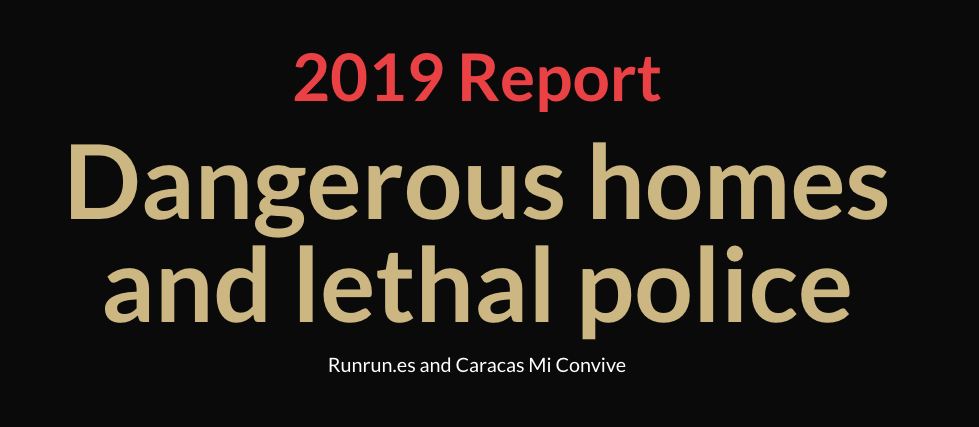
Texts: Lorena Meléndez, Santiago García y Héctor Navarro.
Data Analysis: Santiago García, Héctor Navarro y Guillermo Sardi.
Infographies: Mayerlin Perdomo
Photos: Carlos Enrique Ramírez
Images treatment: Abrahan Moncada
Design: Carmen Riera
Editorial coordinator: Ronna Risquez
Directors y co-founders: Roberto Patiño y Nelson Eduardo Bocaranda Manager: Guillermo Sardi. Management coordination: Carmen Riera Editorial coordinator: Ronna Risquez Knowledge Unit coordination: Santiago García. Technical coordinator: Héctor Navarro.
Monitor de Víctimas was born as a journalistic initiative of the Venezuelan digital news portal Runrun.es and the non-governmental organization Caracas Mi Convive. The objective of Monitor de Víctimas is to systematize the collection of data on homicides that occur in Caracas, one of the most violent cities in the world. This compilation of cases was done by reporters from the police source spontaneously and empirically.
